
NOVEMBER/DECEMBER 2024







NOVEMBER/DECEMBER 2024





Fruita artist Pavia Justinian captures the people, businesses and community of the Western Slope through her outdoor murals and sculptures. story by Heidi Pool and Tom Hess
The history of the Stanley Hotel in Estes Park comes alive with crystal balls, frozen bodies, haunted rooms and one nightmare that became a cult classic. story by Peter Moore photographs by Erik Makić
At Safta in Denver, Chef Alon Shaya crafts culinary delights inspired by his grandmother’s recipes, his Jewish heritage and the flavors of the Middle East. story by Shlomit Ovadia photographs by Anne Stephenson
Poets, bards, yodelers, singers and musicians come together in Golden for the Colorado Cowboy Gathering, a celebration and love for Western culture. story by Corinne J. Brown photographs by Bill Patterson


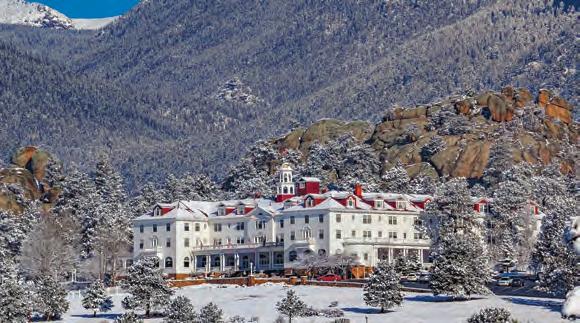
The Stanley Hotel in Estes Park has shared its rich history and supernatural allure with guests for 115 years. Story begins on page 22.
PHOTOGRAPH BY CHRIS
AMUNDSON
10 Sluice Box

A Westcliffe artist depicts the simple life along the Sangre de Cristo mountains; mini art galleries pop up in Denver neighborhoods; a Salida author welcomes readers to her table, sharing stories and recipes from her cattle ranch.
16 Trivia
What’s in a name? Answer these questions about Colorado’s toponyms. Answers on page 53.
18 Top Take
Dawn Wilson captures the Chapel on the Rock on the Peak to Peak Highway in morning light after a recent snowstorm.
36 Kitchens
Save these orange dessert recipes for your holiday feasts.

Estes Park p 22
Allenspark p 18
Broomfield p 10
Denver p 10, 30, 46
40 Poetry
Colorado poets marvel at the majesty of dark skies framed by mountain peaks, city skylines and camping tents.
46 Go.See.Do.
Snow enthusiasts usher in the winter season at Ullr Fest in Breckenridge; Denver’s Christkindlmarket begins with more than 40 vendors sharing specialty crafts, brews and bites.
52 Camping
Hikers and campers find more than 300 campsites at Eleven Mile Canyon near Lake George.
54 Peak Pixels
Early winter at Emerald Lake reveals delicate ice formations on the surface of the waters.


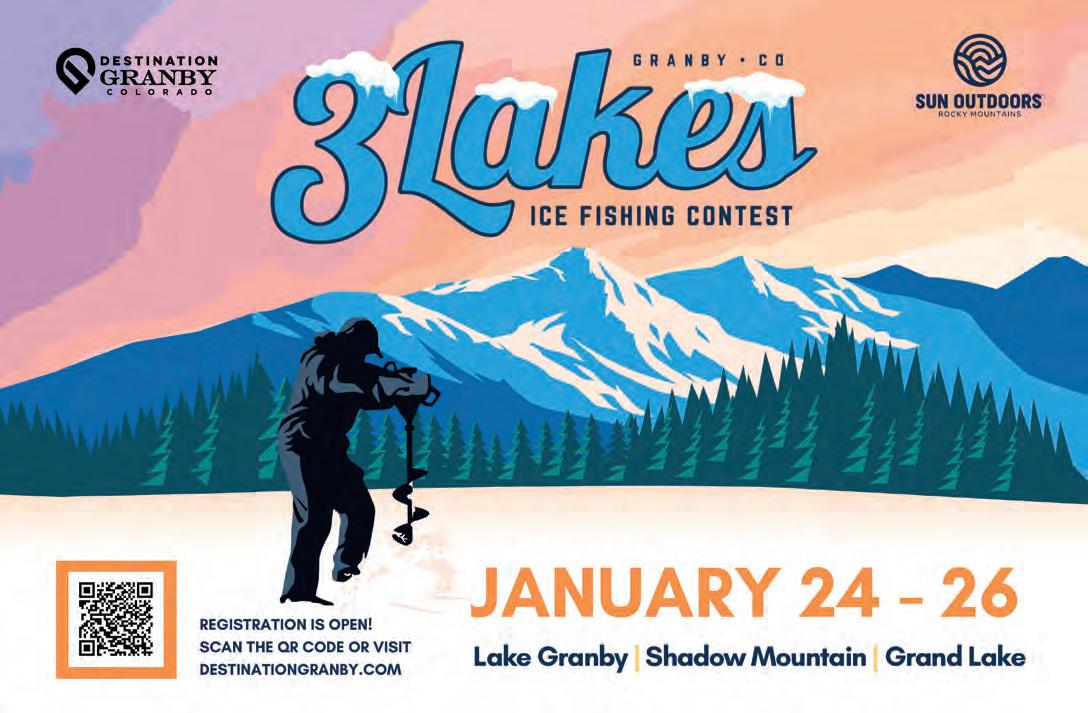

NOVEMBER/DECEMBER 2024
Volume 13, Number 5
Publisher & Editor
Chris Amundson
Associate Publisher
Angela Amundson
Managing Editor
Lauren Warring
Assignment Editor
Victoria Finlayson
Design
Jennifer Stevens, Mark Del Rosario
Lydia Paniccia
Staff Writer
Ariella Nardizzi
Photography Coordinator
Erik Maki
Advertising Sales
Sarah Smith
Subscriptions
Liesl Amundson, Janice Sudbeck
Colorado Life Magazine
c/o Subscriptions Dept. PO Box 270130
Fort Collins, CO 80527
970-480-0148
ColoradoLifeMag.com
SUBSCRIBE
Subscriptions are 1-yr (6 issues) for $30 or 2-yrs (12 issues) for $52. Please call, visit NebraskaLife.com or return a subscription card from this issue. For fundraising and group subscription rates, call or email subscriptions@coloradolifemag.com.
ADVERTISE
Advertising deadlines are three months prior to publication dates. For rates and position availability, please call or email advertising@coloradolifemag.com.
CONTRIBUTE
Send us your letters, stories, photos and story tips by writing to us, emailing editor@coloradolifemag.com, or visiting ColoradoLifeMagazine.com/contribute.
COPYRIGHT
All text, photography and artwork are copyright 2024 by Flagship Publishing, Inc. For reprint permission, please call or email publisher@coloradolifemag.com.
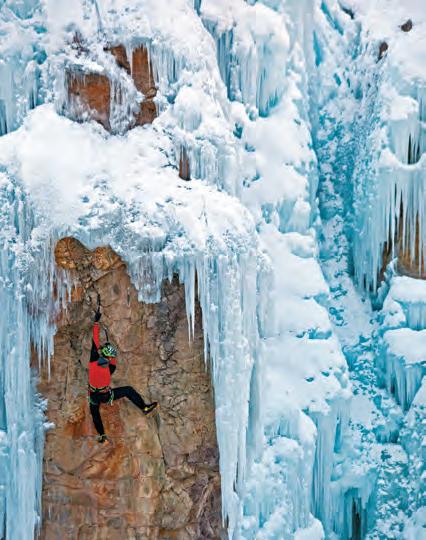



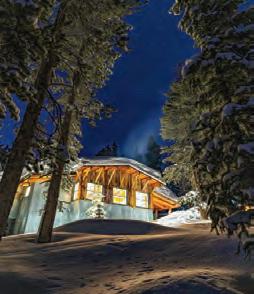

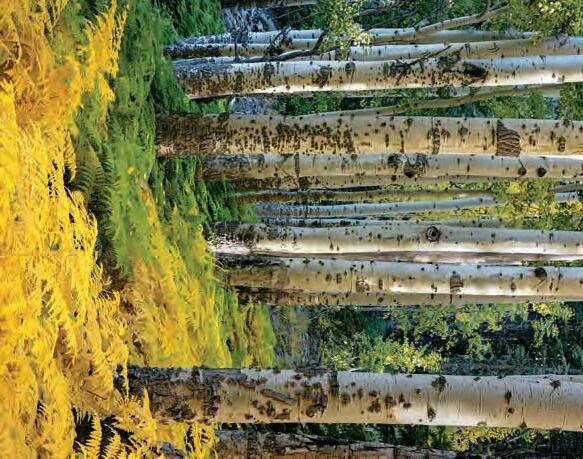


Colorado Life Magazine celebrates the people, places, history, food and culture that make Colorado





by LISA TRUESDALE
Some artists struggle with finding inspiration, but not Andy Mast. The picturesque mountains and sprawling ranches in Custer County provide him with everything he needs. His graphite pencil drawings depicting realistic scenes of cowboys, horses, people and landscapes have won international acclaim.
“Indeed, I am grateful every day to live here, because inspiration is never a challenge,” he said. “It would take more than a lifetime to explore all the nooks and crannies in the Wet Mountain Valley.”
Mast’s mother said he had a pencil in his hand before he could even walk, and by age 10, he knew he wanted be a professional artist someday. Though he realized that doing so would require numerous sacrifices, he was willing to do whatever it took to pursue his passion.
Growing up in the Midwest in an Amish household, Mast had to wait until his arduous farm chores were done each day before he could even think about putting pencil to paper. This often meant drawing late into the night, with only a lantern for a light.
Mast had no formal art training, and he never had a “real” full-time job because he was focused on his art. What he did have was a dream of living in the west, so he started saving money from odd jobs like cleaning barns, bucking bales and mowing lawns. He moved to Colorado in 2015, when he was only in his early 20s.
Calling his works “pencil drawings” doesn’t really do them justice. “My style of artwork is very labor-intensive, with many layers,” he said. “I strive to get a strong contrast, light, shadow, space, depth and

temperature.” Each one of his highly detailed drawings takes dozens of hours.
Though Mast travels the world exhibiting his works at museums and art shows, his forever home is in Westcliffe, where he opened his own gallery in 2023. He offers high-end giclée prints of his originals in different sizes.
The contemporary, light-filled space is also his working studio, so if the timing is right, visitors might catch him at his drawing table, working diligently on his next masterpiece.
“True art is expressed and felt with the heart, and my work represents simplicity and kindness,” Mast said. “It is my desire that my works may bring even the smallest amount of hope and peacefulness to an uncertain world, and there is so much more inside of me just waiting to happen.”

by ERIC PETERSON
In the heart of Denver’s Overland neighborhood, creativity flourishes in an unexpected form: a Free Little Art Gallery (FLAG). Similar to the Free Little Libraries that pepper front yards across Colorado, these miniature galleries aim to spread culture – at no cost and on a very small scale.
The concept is simple and delightful: Stop by on a walk, admire the tiny art, and, if inspired, leave your own creation or take a piece home. The only rule? It has to fit in the box.
This charming idea originated in the Pacific Northwest, where the first FLAGs appeared in cities like Seattle and Portland about five years ago. For Overland resident Grace Trautman, it was a story of serendipity. After learning about a FLAG in Spokane, she became fascinated. “I became obsessed,” she admitted.
With the help of her father, Trautman brought her vision to life. Using repurposed materials, they built a gallery complete with a transparent front door, shelves and solar lighting. She unveiled it in her front yard on Oct. 30, 2022, just in time for Halloween.
Trautman’s rules are as welcoming as the gallery itself: Anyone can contribute art, regardless of skill level or medium. It didn’t take long for the FLAG to become a neighborhood landmark, regularly stocked with tiny paintings, intricate sculptures and quirky creations from artists of all ages.
“I just love the idea of community,” Trautman said. “It’s been such a fun way to connect with my neighbors and share a little love.”
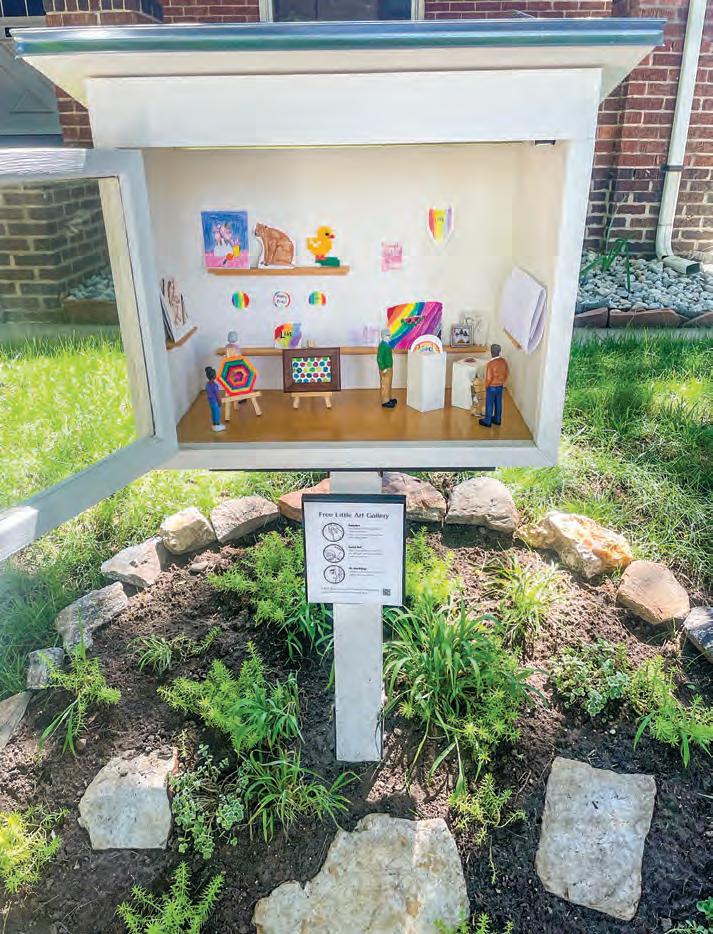
Denver neighborhoods are home to Free Little Art Galleries (FLAGs), collaborative boxes where anyone is welcome to add mini art pieces to the ever-changing collection.
Her gallery has also sparked connections beyond Denver. Trautman trades art with FLAGs as far away as Palmer, Alaska, and uses the map at FreeLittleArtGalleries.art to visit other galleries on her travels. “Whenever I go anywhere, I look up that map to see where they are,” she said. There are now hundreds across the United States, with about 25 scattered across Colorado, from Durango to Greeley.
In Broomfield, artist Arlo White offers a unique twist on the FLAG model. His gallery, dubbed The Hypnotic Turtle DreamBox, features curated exhibitions rather than the take-or-leave approach. Inspired by Portland’s streetside galleries in 2019, White created two boxes: one showcasing his own installation and another for rotating exhibits.
“I want to inspire the next generation,” White said. “It’s important for kids to see

that you don’t have to stop being creative as an adult. You can still be a child at heart.”
Back in Overland, Trautman’s gallery faced an unexpected setback in May when a thief stole all the art, including its miniature patron figurines. The loss was heartbreaking – until anonymous artists rallied to lift her spirits. A few days later, they delivered whimsical pipe-cleaner flowers, complete with a “grand opening” sign and a note of encouragement: “Don’t be sad.”
Touched by the gesture, Trautman watched as her FLAG bounced back stronger than ever. Neighbors and strangers alike contributed new art, filling the gallery with an outpouring of creativity.
For Trautman and others like her, these little galleries are more than boxes of art – they’re vibrant hubs of community, connection and joy, capturing the quirky, collaborative spirit that makes Colorado life so unique.
There’s a dining table in a farmhouse, on a cattle ranch near Salida. Lovingly handcrafted from five lengths of Englemann spruce, this impressive table seats 14, or maybe 16 if you’re willing to get cozy, elbows touching.
In Lara Richardson’s new memoir, The Table: Seasons on a Colorado Ranch, she explains how the carefully cut and stained wood is naturally a gathering place for the family’s meals. This table, made by her husband Andrew with a little help from her, is where she serves delicious meals made with her garden-fresh produce, from the fresh fruits of summer to the hearty soups and stews of fall and winter. It’s where all seven family members blow out the candles for their seven summer birthdays. It’s where they welcome guests for abundant holiday meals.

Richardson’s book is filled with stories about ranching life, from ho-hum-sounding daily chores to important issues like conservation easements and cattle branding. There are also heartfelt tales and precious memories that transport the reader directly to the ranch, to experience all four seasons there, and the good and not-so-good parts of each.
“When life feels unstable and inconsistent, the ranch offers a gift: There is always work to be done,” she wrote. “Working outside, no matter the weather, offers a healthy dose of reality and perspective, reminding me that the world is much bigger than my circumstances, emotions and struggles.”
Yet for Richardson, the table is much more than just furniture; it represents all the joys and challenges of living on a working ranch. It’s where the whole family huddles up each morning to go over the plans for the day, whether it means tending the ranch’s 300 Hereford cattle or running the kids to soccer games. It’s where they’ve celebrated untold joys together, and also where they’ve experienced heartaches and mourned losses.
By inviting readers to read her book, Richardson is also inviting them to gather around her beloved table. So, as a bonus, the book ends with a selection of her favorite recipes, including Branding Day Chili and her famous Pumpkin Muffins.
The Table: Seasons on a Colorado Ranch by Lara Richardson University Press of Colorado 302 pp, paperback, $20

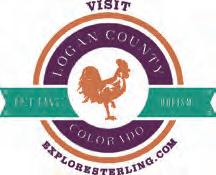





Colorado Springs is a destination for the curious. Explore new terrains, a vibrant downtown and endless natural beauty.
There are more than 55 exciting things to see and do in the Pikes Peak Region, including thrilling whitewater rapids, awe-inspiring parks and trails, museums, attractions and a mountain zoo sure to deliver unforgettable family-friendly experiences.
VisitCOS.com

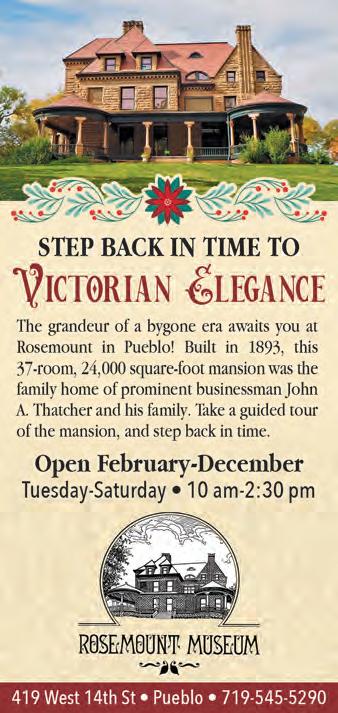

Name these places in Colorado. by BEN
KITCHEN

1 What Colorado city is about 170 miles southsouthwest of Casper, Wyoming, as the crow flies? The city is named for a man named William; William’s son Caspar is where Casper gets its name.
2 Triceratops Terrace and Diplodicus Drive are two thoroughfares in what northwestern Colorado town that gets its name from a National Monument?
3 What statutory town gets its name from a prospector’s prediction of its silver mining scene? In its heyday, miners chased lady luck until they finally struck, though there are only 17 residents now. No word on if any are part of the Cartwright family.
4
Which statutory town claims it was named for the quality of coal mined there, though a couple sources assert that it may be named for a city in northern Wisconsin that lies on a Great Lake?
5 In 2023, Mount Evans had its name changed to what, a tribute to the Cheyenne and Arapaho Tribes? The new name also describes something that could be seen from the mountain on a clear day.
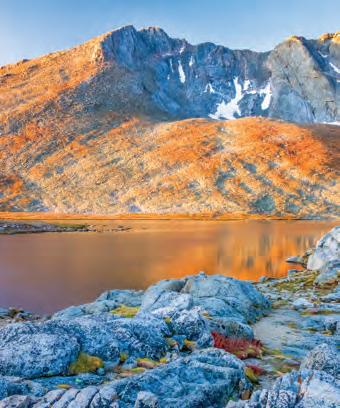
6
Which Colorado county is named for the Colorado River?
While the river’s name has changed, the name of the county honors the river’s original name.
a. Costilla County
b. Eagle County
c. Grand County
7
Which of the following is the name of an unincorporated community in southwest Colorado, named for the presence of certain black and yellow striped stinging insects in the area when it was settled?
a. Bee
b. Wasp
c. Yellow Jacket
8
Many of Colorado’s counties are named for politicians. Which of the following is not named for a man who served as President of the United States?
a. Washington County
b. Adams County
c. Jefferson County
9 Several locations throughout Colorado have metallic names, but which of the following is named for a person?
a. Golden
b. Silverton
c. Copper Mountain
10
Only one Colorado county is named for an element, but the name is in Spanish: La Plata County. What’s the English translation of “La Plata?”
a. The Gold
b. The Silver
c. The Copper

11
The marble used for the floors in the state capitol is Yule Marble that was mined around the Gunnison County statutory town of Marble. The town of Marble is named in reference to a Yule Marble quarry.
12
The spelling of Cañon City is due to a misunderstanding: it was supposed to be called “Canyon City,” but it was reported with the Spanish word for canyon.
13
Pikes Peak is named for Zebulon Pike, noted for being the first person to summit the mountain.
14
As the name suggests, Twin Lakes consists of two lakes that are very close together, connected by a narrow channel. However, the lakes aren’t individually named beyond descriptors like “Upper Twin Lakes” and “Lower Twin Lakes.”
15
The name of the town of Eads is short for “east and down south,” a reference to where Eads is within the state of Colorado. ”

No peeking, answers on page 53.

PHOTOGRAPH
BY
DAWN WILSON
THE MORNING AFTER an April snowstorm in 2021 ripped down the Peak to Peak Highway 12 miles south of Estes Park, photographer Dawn Wilson stood on the edge of a pristine, white expanse, boots sunk in fresh powder. The winds, usually relentless on this stretch of highway, were still.
The historic Saint Catherine of Siena Chapel, or Chapel on the Rock, wore a fresh coat of snow. The sun cast its easterly golden light across the church’s stone walls and stainedglass windows. In the shadow of 13,916-foottall Mount Meeker, the nearly 100-year-old functioning Catholic church perches atop a riveting rock formation. It’s said to be the only church in Colorado blessed by a pope.
A self-proclaimed snow lover, Wilson said, “When a fresh snowfall covers everything in pure white, I like the juxtaposition it gives with the religious connotation of purity.”
Since she laid eyes on it two decades ago, Wilson has captured this spot hundreds of times in every season. Her slow shutter speed, complemented by a tripod to avoid blurriness, is what allowed her to record both the snow’s blinding vibrancy and subtle shadows.
Although this shot was one of her most challenging in this location, Wilson said there’s still one image that eludes her: a moose standing in the willows south of the church. One day, she said, she’ll be ready when it happens.
This photo was shot with a Nikon D850 camera with a 24-70mm lens, shot at 24mm at f16 for 1/60 sec, ISO 80.
SUBMIT YOUR BEST photographs for the opportunity to be published in Colorado Life. Send digital images with descriptions and your contact information to photos@coloradolifemag.com or visit coloradolifemag.com/contribute.



Fruita artist weaves her community and its surroundings into vibrant murals and sculptures that capture the heart of the Western Slope.
story by HEIDI POOL AND TOM HESS
AT RIM ROCK Elementary School in Fruita, all six grades had a hand – literally – in transforming the front of their red-brick building. The mural they created with local artist Pavia Justinian depicts a lynx, their school mascot, scaling six panels of the iconic Colorado National Monument. The lynx’s ascent is more than a striking image; it symbolizes the students’ journey through six years of education.
The students played an active role in bringing their vision to life. After representatives from each grade chose Justinian as their artist, she worked with small groups of four to six students at a time to paint the mural. The project became a lasting memory for the kids and a source of pride for the school.
But Justinian’s creative impact on Fruita doesn’t stop at Rim Rock. Across town, Fruita Middle School students joined her in transforming a 75-foot-long bike and
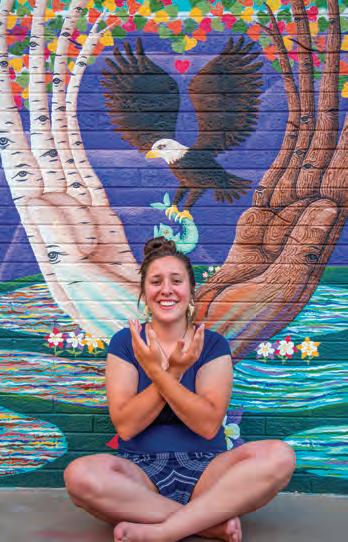
pedestrian tunnel beneath U.S. Highway 50. As part of a summer camp project called Wellspring, they painted a mural that traces the Colorado River’s journey –from snowmelt in the high country to the parched landscapes downstream, touched by wildfire and drought.
Justinian’s love for the Western Slope began in childhood when her family moved to the region. The contrasts of red rock formations, green vegetation and the wildlife – such as bighorn sheep – captured her imagination. Even the debris scattered across the desert became a source of inspiration.
For decades, artists in the Grand Junction area have scavenged discarded metal and junk for their projects. The practice earned the city the unflattering nickname “Junktown,” but Justinian sees beauty and
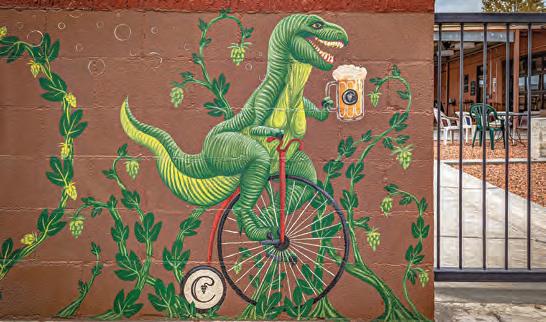
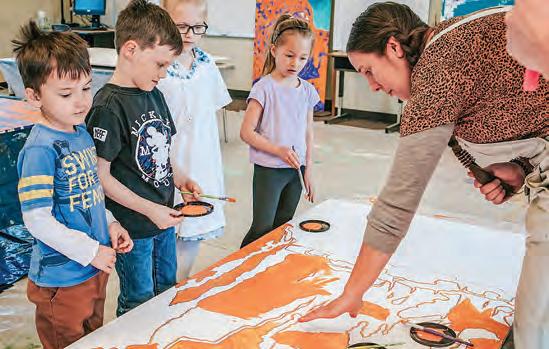


potential in these remnants of the past.
When the son of a retired local artist offered old car bumpers from the 1950s and ’60s for sale, Justinian jumped at the chance. She purchased the lot and turned the vintage metal into her largest project to date: a pair of bighorn sheep sculptures displayed at a Grand Junction roundabout near the Hartmann Farmhouse on Broadway.
The installation, known as The Redlands Project, features two massive rams – 10 feet tall and 10 feet long – locked in combat. With their heads bolted together, the sculptures mimic the behavior of the wild sheep that roam the nearby cliffs.
“I’m trying to bring that magic down into the city,” Justinian explained.
To create the sculptures, Justinian repurposed tractor grilles for the rams’ ribs, vintage fenders for their hindquarters and corrugated roofing for their legs. “Pieces that already have a natural curve are perfect for creating musculature,” she said. “Older car fenders have these beautiful organic forms, whereas modern ones are more geometric – they feel less alive.”
Using salvaged materials isn’t just an artistic choice for Justinian; it’s a statement.
“Reclaiming junk reclaims the nickname ‘Junktown’ and turns it into something positive,” she said.
The rich colors of Justinian’s environment inspire her paintings, which often echo the red rock hues of the Western Slope. While she cherishes camping under the stars, she admits she’s not an avid hiker.
“I’m not a huge hiker. I don’t like sweating in nature,” she quipped.
Her aversion to the Western Slope’s relentless sunshine – 300 days a year – has even shaped her approach to art. She discovered the challenges of outdoor painting early in her career when she tackled her first mural: an electrical box featuring Kokopelli, the Southwestern deity, riding a bike.
“I learned the hard way that you need bonding primer to paint metal in the hot sun,” she said. “That project also taught me how to create a two-dimensional scene on a three-dimensional object. People would stop by, park their cars and watch me work – it was a great introduction to public art.”
Nowadays, Justinian’s work can be found in less conventional places, like the fence of Copper Club Brewery in Fruita. There, she painted local icons Greta the Dinosaur and Mike the Headless Chicken – on bikes, of course.
Justinian’s husband, Shanachie Carroll, plays a vital role in her creative process. A public library manager and photographer, Carroll documents Justinian’s work, from murals to sculptures, providing fresh perspectives when she’s stuck.
“He’s got a great eye for art,” Justinian said. Carroll’s insight proved invaluable when Justinian struggled with an abstract sculpture made of epoxy and rusted metal. At his suggestion, she painted a turquoise river running through the piece, uniting the contrasting materials.
“The river brought it together,” she said, drawing a connection to the Colorado River that sustains the Grand Valley’s communities – Fruita, Grand Junction and Palisade alike.
Through her art, Justinian channels the landscapes, wildlife, and people of the Western Slope, creating pieces that bring her community together and turn the ordinary into the extraordinary.
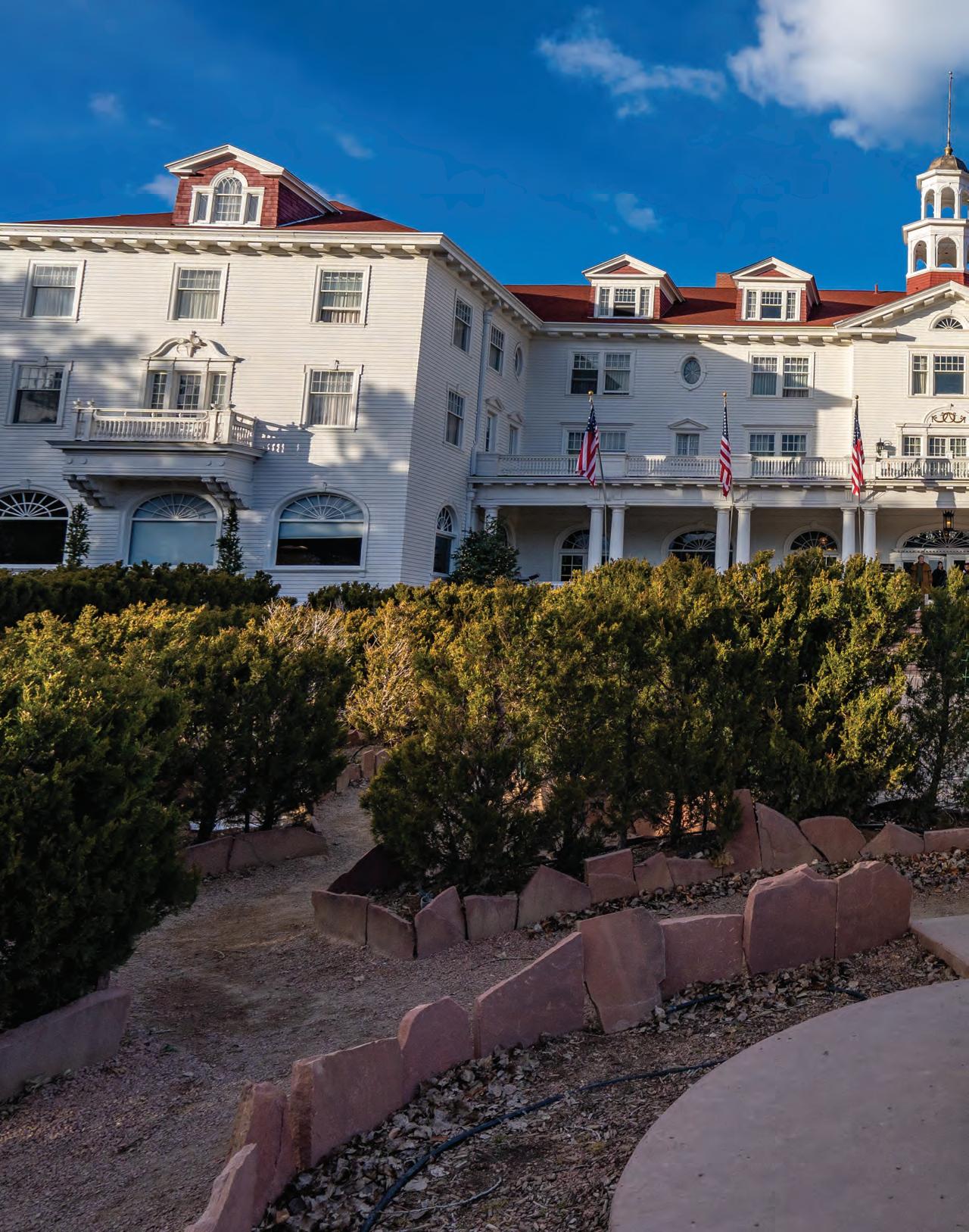
At The Stanley Hotel in Estes Park, the Rocky Mountain views are only half the story.

ACCORDING TO OUR tour guide Gabe, some guests enjoy The Stanley Hotel so much that they check in but never check out. He’s trying to creep us out, and he’ll have some success.
I’m on the 10 p.m. tour, which commenced in the hotel’s basement, right near the creepy underground tunnels and a mysteriously empty fish tank.
It’s a moonless night in Estes Park, so there’s no sign of the snow-capped ridges of Rocky Mountain National Park, 10 miles west and 8,000 feet above the front porch of the late Freelan Oscar “F.O.” Stanley’s legacy. But there will be plenty to see, even in the dark.
One fellow tourist is all geared up to detect spiritual emanations, brandishing her K-II EMF (Electromagnetic Field) Meter. The device looks like a TV remote, but it’s designed to measure ectoplasmic electromagnetic fields, and it displays the results in increments from 1.5 to 20+mG. Evidently ghosts are all about EMFs and photobombing, as we’ll see later in the tour.
Tour guide Gabe leads us along a dark sidewalk to a concert hall on the Stanley grounds. As we make our way inside, he pointedly avoids turning on the lights, for extra creepiness. We find our way into seats in the murky space, and then he tells us about a dozen spirits who may or may not be on the tour with us.
There’s Paul, who manifests as a shadow figure. And Dennis, so called because he is a mischievous menace. And Lord Dunraven, who guzzles sealed liquor bottles and lasciviously invites women to join him in room 401. (Don’t go!) Pierre, the Stanley streaker, nakedly haunts redheads. Our tour guide backs this up with photo evidence of each of these spirits, shared – he says – by tour guests just like ourselves!
He also points out that Bob Dylan once performed on that very stage behind him, which we can’t see very well, on account of the dark. But it does make you wonder: In the post-Dylan future, will the ghost of Bob go electric with an EMF supernova? And will his lyrics make more sense, or even less, from the great beyond?
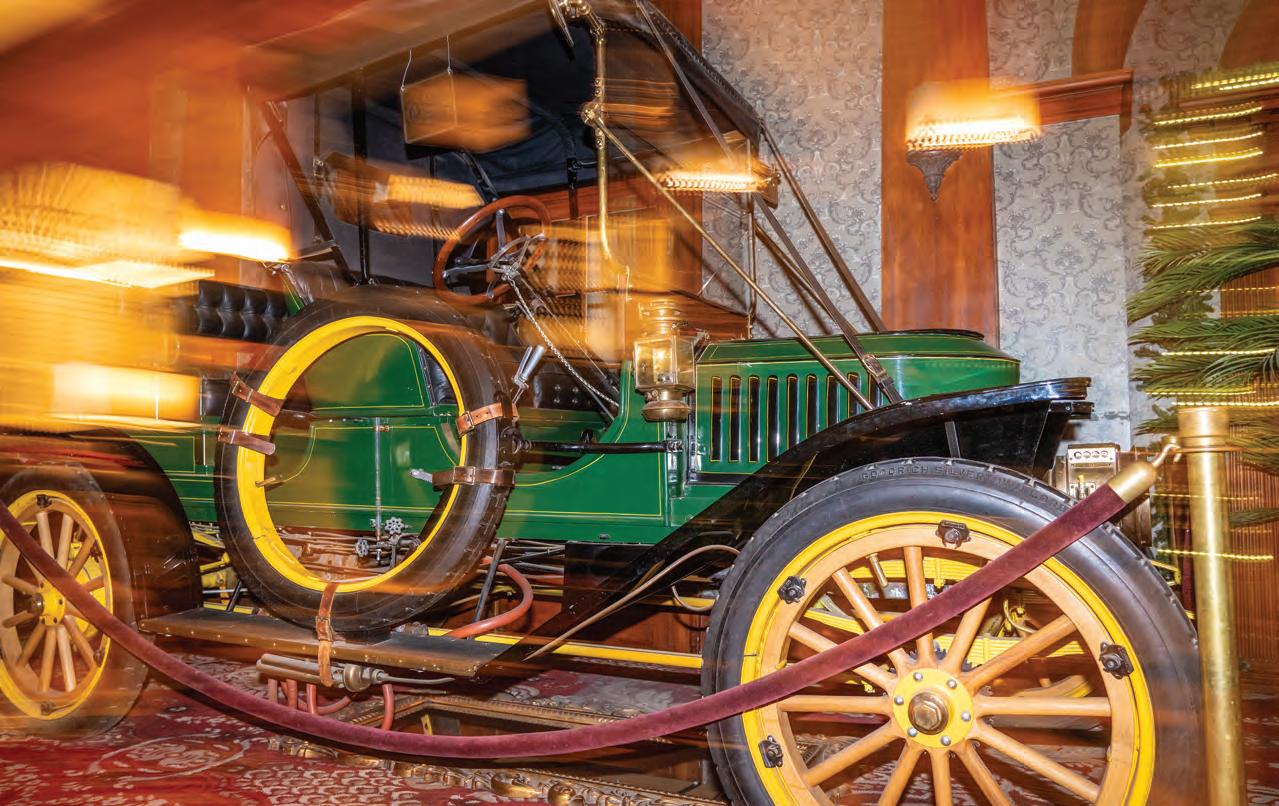
THE STANLEY HOTEL is the showplace of Estes Park – its structures resemble a series of fancy red and white hats dropped onto a ridge above downtown. You can’t miss it, unless you happen to be staring in the opposite direction, at the high-mountain highlights that have been drawing visitors from around the world to Estes Park for a century and a half.
F.O. Stanley opened the hotel in 1909; it has since added a dozen outbuildings, a spa and sauna, restaurants, wine and whiskey bars and surrounding labyrinths (more on that, later). Stanley was a polymath and renaissance man born in 1849, in Kingfield, Maine. He launched a maple-syrup business at age 9, and two years later learned to play, build and sell his own violins. After graduating Bowdoin College, he and his twin brother, Francis Edgar Stanley, packaged up protractors, compasses and other nerd necessities in the Stanley Practical Drawing Set. Then, their factory burned down. Undaunted, the brothers went on to revolutionize photography, developing dry plates that could register an image in minutes, sparing subjects an hours-long,
stiffened pose. When they opened the Stanley Dry Plate Co. in Lewiston, Maine, the world’s photographers beat a path to their door. They made a million bucks a month in modern dollars, then sold to George Eastman, whose Eastman Kodak Co. brought photography to the masses.
For their next trick, the Stanley brothers thought: Let’s invent the motorcar! The brothers’ photo operation stood next to a bicycle factory. When Francis’ wife, Augusta, took a bike out for a spin, she tumbled into the street and swore never to mount that infernal contraption again. No worries, Francis said, I’ll build you a four-wheeled vehicle that doesn’t require balance to operate.
And he did: the famous, hand-cranked Stanley Steamer.
Cars soon ruled the road, but not the Stanley’s version. “The electric starter on the internal combustion engine knocked the wind out of their sails,” said James Pickering, author of the book Mr. Stanley of Estes Park. “Nobody wanted to fuss with cranking up that steam engine anymore.”
Even though Henry Ford’s Model T carried the day, the Stanley Steamer was
around long enough to deliver the world to The Stanley Hotel.
It was lung disease that first brought F.O. Stanley to Estes Park. In his day, there was only one cure: Leave for higher ground.
“F.O. was in the care of Sherwood Bonney, who vacationed in Estes Park,” Pickering said. “He could have sent the Stanleys anywhere, but he sent them there.”
F.O. and his wife, Flora, hopped the next westbound train from Newton, Massachusetts, to Lyons, then took the eight-hour horse-drawn carriage ride up Big Thompson Canyon. Estes Park town wasn’t much of a place – just low buildings below some very tall mountains. There wasn’t even a national park yet. But when F.O.’s health improved, he began breathing life into Estes Park.
ENTER THE STANLEY Home Museum
after spending time in the lobby of Mr. Stanley’s hotel, and you just might have a creepy feeling of deja vu. Both buildings have the same curving balustrades framing a sweeping central staircase leading up to stunning stained-glass windows, and rooms left and right to welcome guests. It’s an architectural testament to one man’s love for his wife.
“Flora was F.O.’s alter ego,” said Nancy Thomas, an Estes Park resident who is writing a biography of Mrs. Stanley. Thomas is also the sister of James Pickering, the author of the F.O. Stanley biography.
Flora developed a degenerative eye disease, so it was convenient that both their home back east, and their 1904 house in Estes Park, were built from the same plans. Their hotel had a similar layout, but on a grander scale. Housekeepers were instructed not to move the furniture around, so that Flora could find her way.
The pair never produced offspring, but they did give birth to Estes Park as we now know it.
In the spirit of “if you build it, they will come,” Mr. Stanley created the town’s first power plant, water plant, golf course, library and even the town dump, according to Pickering. Meanwhile Flora was a founding member of the Estes Park Women’s Club, fundraising for the ideas she and her husband dreamed up.
That’s how Flora found herself in “gypsy” garb, in front of a crystal ball, dispensing fortunes to the townspeople in a leaking tent during a fundraising bazaar. She racked up a full $10.16 in the process and earned herself a lasting reputation. “There was quite a lot of that fortune-telling stuff going on at that time,” Thomas said. “She and F.O. had a good laugh over it.”
Thomas says Flora probably deserves a better representation. She was a graduate of Bates College, in Maine, back when few women attended college, met her husband while teaching school in Mechanic Falls, Maine, and was a concert-level pianist.
As they developed their summer home west of the hotel, on Wonderview Avenue, the Stanleys invited a hifalutin crowd back east to come out and breathe deeply. Theodore Roosevelt, John Phillips Sousa, the “Unsinkable” Molly Brown of Titanic fame,
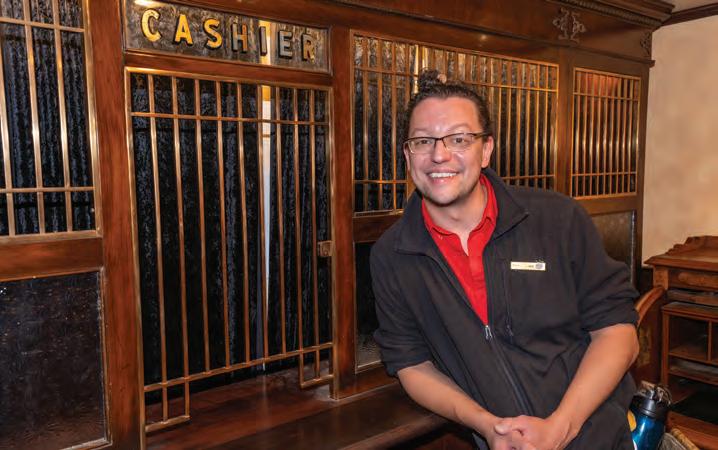



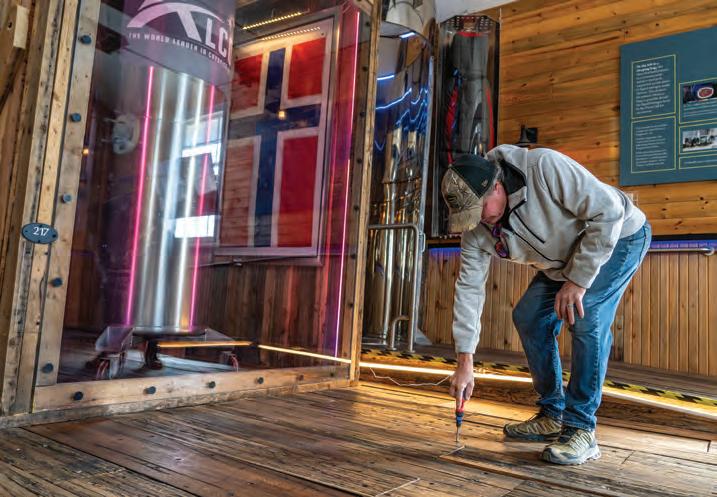
The hotel’s haunted charm has only grown over the past 115 years. Daily tours tell of mirrors with trapped souls, Grandpa Bredo Morstøl’s frozen body and the newest oddity: leaving money beside Bevis, a short black cocker spaniel statue belonging to a groundskeeper in 1909.

plus a full pen of Hollywood peacocks, would pass through The Stanley Hotel doors. Many of them arrived in specially outfitted Stanley Steamers autos, which cut transit time from Denver by eight hours and untold horse-watering stops.
Once the world noticed Estes Park, its fate as a vacation destination was sealed. Mr. Stanley personally backed efforts to create Rocky Mountain National Park in 1915 and supported the restoration of elk to their natural habitat in the high country.
In 1926, the Stanleys sold their stake in the hotel for $800,000, and bought it back out of bankruptcy in 1929, then resold it almost immediately.
F.O. Stanley missed the decline and near ruin of his hotel, dying in 1940, as he walked out to pick up his morning newspaper. Even as the hotel received a designation on the National Register of Historic Places, it operated without heat in winter.
IT WAS INTO THIS RIOT of decay that a scruffy alcoholic writer, plus his wife and son, pulled up in front of the Stanley, looking for a place to stay for the night. They arrived in late October 1974, the hotel was about to close for the season, and staffers were vanishing for the winter. Nonetheless, the trio was offered room 217, if they were willing to pay cash: The credit card machine was heading back to Denver for the winter. The family ordered dinner in the grand ballroom, all alone, with chairs up on surrounding tables and canned orchestral music piped in over the speakers. A bartender named Grady manned the cocktail shakers.
During the night, the husband was awakened by a nightmare about their son being chased down the hallways by a firehose, so he stepped out onto the porch to have a cigarette. That’s when he envisioned a story about an alcoholic caretaker who goes mad during a winter with his wife and son at the Overlook Hotel.
Does any of this sound familiar?
The guest, of course, was the novelist Stephen King, and his book The Shining, plus the 1980 Stanley Kubrick film loosely based on it, would go on to join the allspook roster of our collective nightmares.
Here’s Johnny!

Gabe the tour guide paused in front of The Stanley Hotel’s grand front porch and gestured up to the very balcony where King knitted together his tale of madness, writer’s block and murder. In fact, this was the only part of the night tour that gave me a chill. Writer’s block is terrifying!
King’s tale – on the page and in Stanley Kubrick’s movie – thrilled the Grand Heritage Hotel Group, and its chief executive officer, John Cullen. The company paid $3.1 million for it in 1995. They renovated the place from floorboards to ceiling and leaned in hard to the “this place is haunted!” reputation, inviting in TV crews from various spooky shows, which in turn fueled reservations for their eleven Shining tours a day, which cost a scary $30 per person.
Since those dark days, The Stanley Hotel has launched a concert/comedian series to provide popular entertainment and opened a spa, bars and restaurants for abundant refreshment. It’s heated year-round now, so the only shivers you’ll feel will come from encounters with the supernatural. To match the Kubrick film, they’ve even added a juniper maze out front, because guests kept on asking where it was. (In King’s novel, topiary sculptures were scary plants.)
And now the hotel is headed for new

owners, backed by the Colorado Educational and Cultural Facilities Authority, if they can work out a deal. The CECFA is a kind of culture bank, extending $7 billion in low-interest loans to Colorado theaters, schools, museums and, quite possibly, creepy old hotels as well. If the deal goes through, they’ll help the Stanley realize its dream (or nightmare) to become a focal point for horror-movie fans and a catalyst for filmmaking in Colorado.
Just in time to welcome the new owners, whoever they may be, the hotel has attracted a new, high-profile resident. In
the spring of 2023, Nederland’s famous Frozen Dead Guy was part of a $250,000 deal to relocate his frosted corpse and his eponymous holiday: Frozen Dead Guy Days. The festival debuted in its Estes Park location last March.
So the chilly corpse of Bredo Morstøl made the journey up the Peak-toPeak Highway to his new climate-controlled crypt in the Stanley. No charge to Morstøl for the uber-air-conditioned suite, but visitors will cough up $20 for a forty-minute visit.
You could consider that a bargain.

GABE informed us that Mr. King’s suite goes for $600 per night. The elevated charges extend to the “haunted” fourth floor, where little-kid ghosts are said to stomp through the hallways all night.
In room 401, above the main entrance, a spectral little girl looked out the window for two and a half hours, goose-bumping a crowd that gathered to watch her. But the family that had rented the room wasn’t there at that time! Or so Gabe told us. The hotel also served as a location for the 1994 yuk-fest Dumb and Dumber, which may also describe the people who take this ghost stuff seriously.
Then again, maybe not. That film’s star, Jim Carrey, was said to have had a ghostly encounter in the hotel, and quickly changed residences for the duration of filming. What sort of encounter? He’s not saying. But Gabe flipped through many images shared by other tour takers, who had snapped photos at Stanley and found spectral photobombers in their digital im-
ages. Seeing is believing, or at least it’s a good excuse to use the full range of photo-enhancing features on your app.
My friends, Ward and Sue, are perfectly normal, intelligent people. He’s an artist, she’s a management consultant, and they bought a night at the Stanley at a fundraiser. They checked in and carried their luggage up to the second floor, where they took a turn toward the King suite.
When they got through the security door, they both felt a tingling sensation and looked at each other: Their hair was standing straight on end, as if they were experiencing an extreme bout of static cling.
On second thought, maybe my friends are nuts. But, in any case, they’re just my third favorite Stanley-visitor-witha-tale-to-tell. Stephen King is number 2, because he saved the place from ruin. And my favorite?
In 2018, the night clerk manning the front desk at the Stanley noted a late-night visitor. He picked up his cellphone in time to capture a brown bear standing on top
of a coffee table near the front door. The beast hopped down, gave the premises a good sniff, then turned to look at the front desk clerk. Amazingly, the video continues as the bear saunters off into the gloom of the lobby.
And yes, I know for sure that this actually happened, because I saw it on YouTube.
Had I been running the front desk that night, I might have suggested that the bear head downstairs to visit the Colorado Cherry Co. It would have loved their cherry hand pies, as I do. In the history of hotel dining, it may be the best thing ever to accompany a cup of coffee.
And if you carry your pie up to The Stanley Hotel’s front porch and take a seat, you can enjoy your treat while taking in the long view that includes the town that F.O. Stanley built, the national park he helped preserve and the elk he invited into town.
If those 2,000-pound beasts are welcome, lounging around the front lawns all over Estes Park, then you surely will be as well. Especially if you believe in ghosts.

Tradition meets innovation at Denver’s Safta restaurant
story by SHLOMIT OVADIA
photographs by ANNE STEPHENSON

DEEP IN THE CONCRETE jungle of RiNo’s bustling arts district lies a culinary gem, where every dish is a Jewish grandmother incarnate, enlivened by the energy, intention and influences from homeland Israel and Bulgaria, Morocco, Turkey, Syria, Greece and Yemen.
The Denver-based restaurant, Safta, which means “grandmother” in Hebrew, pays homage to Chef Alon Shaya’s late grandmother, Matilda. Every dish is an exposé that charts the chef’s life as he rediscovers his heritage.
Safta opened its doors at The Source Hotel at 3330 Brighton Blvd. in 2019, offering reinvented Israeli flavors. Industrial meets contemporary modern in the hotel’s main hall, home to independent art shops and eclectic eateries. Low-rise suede couches surround naturalistic wooden coffee tables, while dark leather chairs, office tables and austere accents intermingle for an edgy feel.
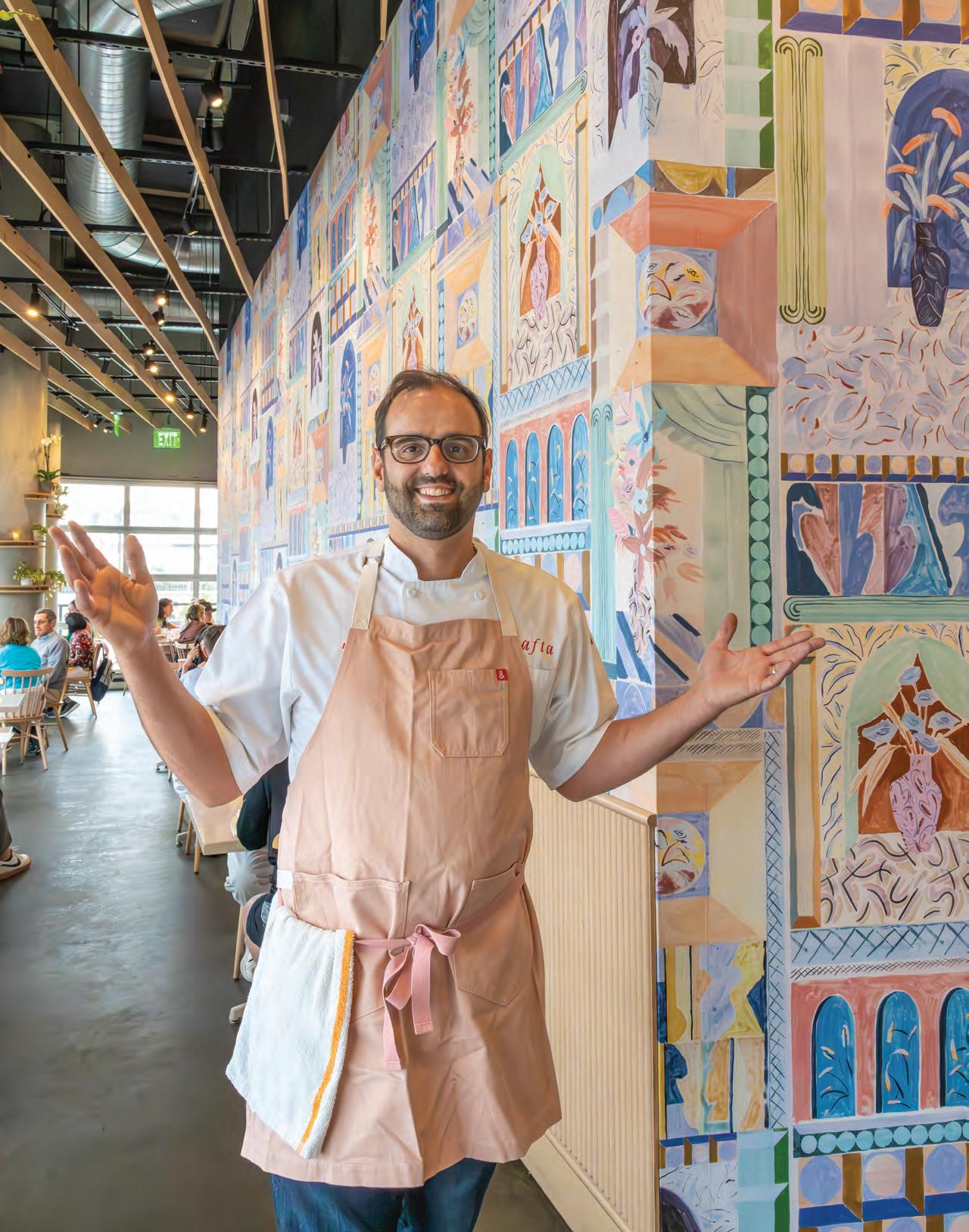
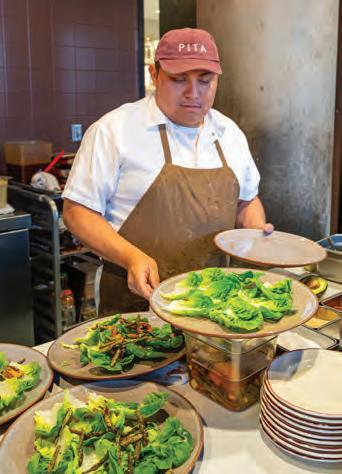

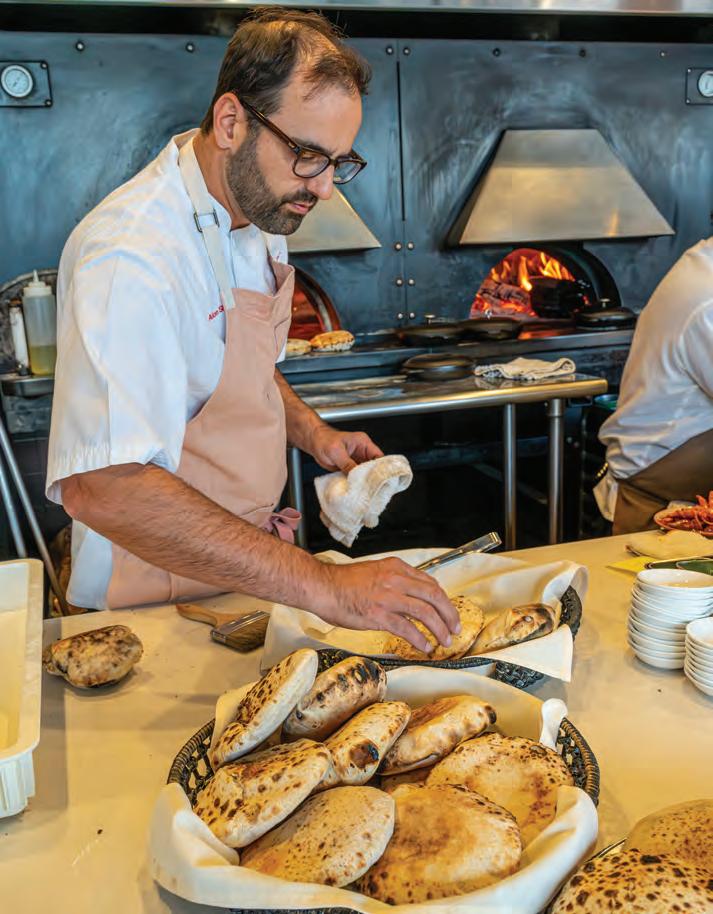
Safta’s curated menu celebrates Israeli flavors and heritage, including woodfired, handmade pita bread made from a 100-year old starter.
Among the lights, concrete and decorum of the hall’s interior stands Safta, subtly recognizable by its signature soft red sign and wooden counters that give way to a bright entrance. The restaurant’s interior is both sleek and inviting. Warm pink tones, an open kitchen, light wood accents, ambient lighting and hanging plants decorate the space.
Vintage pink rose designs dot glassware, inspired by Alon’s late grandmother’s artwork. Floor-to-ceiling windows offer clear views of the Denver skyline, where a stellar sunset complements the snowcapped Rocky Mountains. A large mural painted in pastels beckons patrons to take a seat, reminiscent of pop-up restaurants of Tel Aviv’s bustling alleyways and lively cafe culture, a bit like “your hip grandma’s house,” said Alon of the comfortable yet elevated fine-dining vibe.
With a philosophy of familial congeniality, hospitality and bonding, freshly cooked meals remain at the epicenter of daily Israeli life. Its cuisine is a diverse fusion of flavors, foods and dishes passed down through generations of Jewish tradition, with heavy Mediterranean and Middle Eastern influences. Alon’s Safta recipes create a unique and tantalizing palate shaped by the stories and customs of this diasporic people.
“Whether I’m celebrating or mourning, or trying to console or impress, food has always been my avenue to do that, so hospitality is something that I love,” Alon said, a connection that binds him to his late grandmother’s caretaker tendencies. “She just knew how to make people feel better.”
Matilda worked as a pharmacist in Bulgaria before fleeing after World War II, settling in the Israeli seaport town of Jaffa in 1948, the same year the country was founded. Although Matilda was known as a quiet woman, her actions and kindness spoke volumes and were known to bring peace to everyone around her.


Alon reflects on the affection his grandmother showed him during early childhood visits to Israel. Matilda would whisk the young, shy Alon through every step of her kitchen processes as she made her most cherished meals for him. She would pause to let him taste subtle additions of anise and sweet paprika to her tomato soup. She assigned him to be her sous-chef by helping with crucial preparatory tasks under her diligent tutelage like grinding the fatty meat for Bulgarian lamb kebabs al ha’esh (over fire).
Back in the United States, upon coming home from school, the smell of roasted peppers and eggplant signified that his grandparents were visiting from Israel. Alon recalls the culinary spoils that saturated those visits, a central inspiration behind Safta’s dishes, where guests choose from family-style entrées, small plates, drinks and a dynamic seasonal lineup.
As owner of Safta, and numerous restaurants across the country with his business, Pomegranate Hospitality, Alon has been nominated for five and recipient of two, prestigious James Beard Awards; named “Best Chef, South” for the Italian pizzeria, Domenica; and “Best New Restaurant” and “Chef of the Year” for New Orleans-based Israeli hotspot, Shaya. Southern Living magazine named Alon one of the “50 People Who Are Changing the South,” and the independent Jewish newspaper, The Forward, listed him as one of the “50 Most Influential Jews in America.”
Despite all the prestige and accolades, Alon came from humble beginnings, dating back to a poverty-stricken childhood. As a young immigrant living in Philadelphia, he battled isolation, constantly fighting the fear of standing out as a 5-yearold who didn’t yet speak English and who was desperately trying to forget his native

Hebrew to “assimilate and put my past behind me,” he said.
Yet something about cooking kept him connected to his roots. Alon spent years learning about other cultures by exploring the world. Culinary school in Italy led to a serendipitous reconnection with Judaism. Throughout his career, he worked in a variety of chef and kitchen managerial roles, which blossomed with his return to remaking foods from his homeland –childhood classics like lutenitsa, hummus and Bulgarian lamb kebabs.
“As I got older and more confident in who I am and my abilities, I wanted to go back to my roots,” Alon said. Talking to his mother about foods he grew up with marked his return to “re-embracing” Israeli gastronomy.
After Matilda’s passing, regular trips to Israel continue to provide inspiration for Alon. There, he finds himself with invita-
tions into strangers’ kitchens. He samples the nostalgic farm-to-table flavors during his exploration of Israel’s outdoor food bazaars known as shuks.
Israeli meals typically begin with salatim, or starters, comprised of small dishes that include dips, salads and pickled bits, often paired with pita bread.
Safta recreates these culinary feats with carefully chosen ingredients and techniques gleaned from Alon’s global travels. He uses 100-year-old starter and freshly milled wheat from Lafayette to make pillowy, woodfired, 3-inch-high pita bread that pairs perfectly with Safta’s signature green olive oil and za’atar blend of herbs and spices. The hummus has an airy texture that comes from carefully removing the skins from each garbanzo bean before blending, which comes in variations that include soft-cooked eggs and foraged mushrooms.

Favorites like harissa roasted chicken, branzino with roasted peppers and Bulgarian lamb kebabs accompany za’atarspiced olive oil and pita bread.
Many Safta diners start with a bright orange muhammara sauce made of roasted peppers topped with hazelnuts, cilantro and chili oil, or they try the crispy eggplant dish, complete with caramelized tomato and herbed goat cheese. Safta’s duck confit, cooked in a sweet apricot sauce and resting on a bed of Lebanese mujadara lentil rice and a tomato vinaigrette, offers a blend of light summer and hearty ethnic flavors.
A delicate balance of salt, fat, acid and heat differentiates Safta from other Middle Eastern or Israeli-specific cuisines, Alon said. While at the heart of Safta lives Alon’s grandmother’s simple recipes, the restaurant accomplishes much more –challenging diners to reimagine fine dining using modernized Israeli flavors.
Before Safta’s grand opening, Alon published a cookbook entitled Shaya: An Odyssey of Food, My Journey Back to Israel. The 400-page cookbook reads more like a novel, following the celebrity chef’s search for identity as a Jewish Israeli-American. Passing on traditions from the ages, a hallmark of Jewish culture, extends beyond the tenets of his grandmother’s cooking.
Alon and his wife Emily adore Colorado, where they spend their summers fly fishing. “Opening Safta in Denver has been a way for us to put some roots down and prioritize our happiness,” he said. Being involved in the community is important to the Shaya family, the chef said. A colorful raconteur and endlessly creative, Alon recently reinvented several recipes from Holocaust survivor Steven Fenves’ 90-year-old family cookbook for a community fundraiser for the United States Holocaust Memorial Museum. Safta also regularly contributes to other philanthropic initiatives, including Jewish Community Center Denver and the Anti-Defamation League.
Above all, for Alon, Israeli food is a fusion of cultures and ethnicities most easily defined as “a melting pot” that blends flavors and stories from the vibrant Middle Eastern region. Food and cooking can capture, recreate and connect those cultures. And true to his childhood, Alon’s beloved Safta remains his guiding muse.
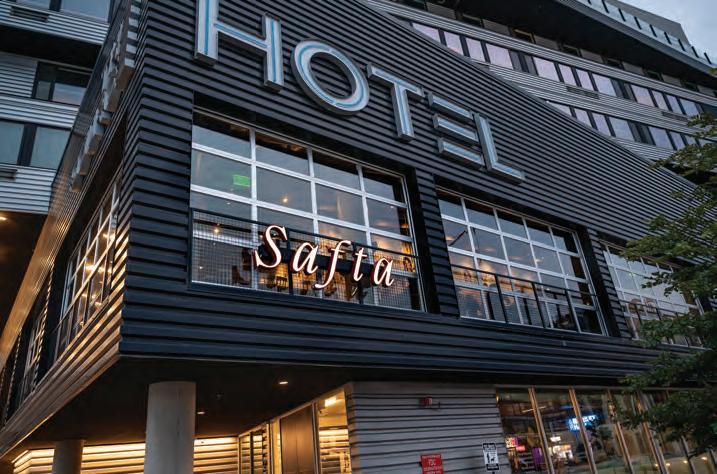
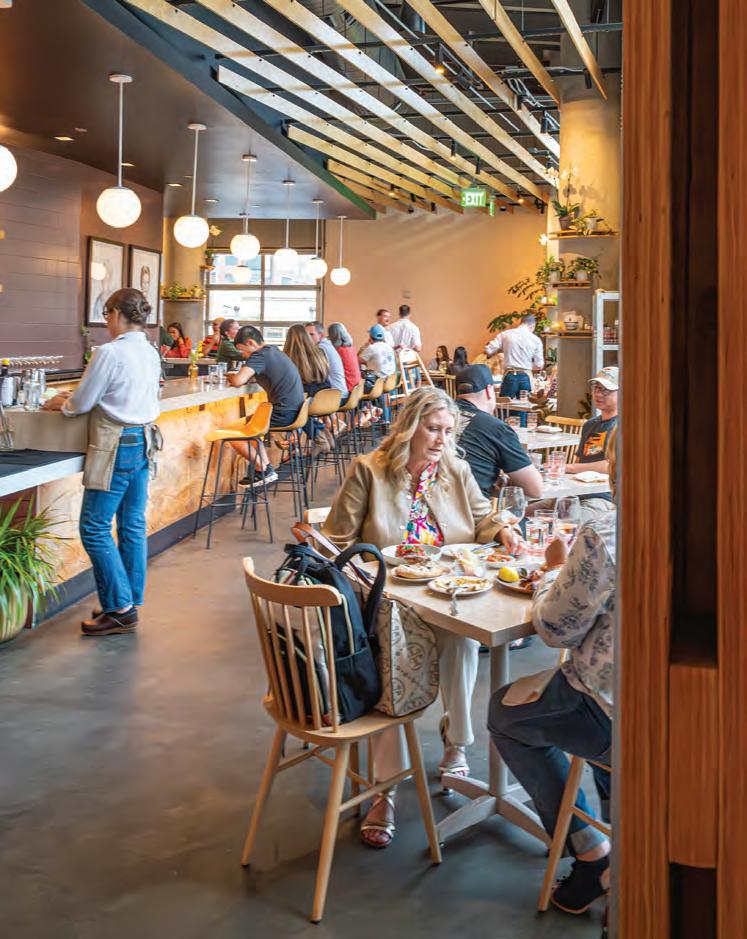

Give the gift of tart & sweet orange desserts
recipes and photographs by DANELLE McCOLLUM
GENERATIONS GREW UP eager for the orange at the bottom of their Christmas stocking. Now the orange can be the star of luxurious holiday desserts that will inspire family and friends to make new holiday traditions and reach for their new favorite sweets.
These melt-in-your-mouth cookies feature chopped almonds, almond extract and orange zest. They’re perfect for your holiday cookie trays, and photo album.
With an electric mixer, beat butter, sugar, egg and almond extract until creamy.
In a separate bowl, combine flour, baking powder and salt. Gradually add the flour mixture to the butter mixture. Beat on medium speed until combined. Fold in the chopped almonds and orange zest.
Drop dough 2 inches apart on lightly greased baking sheets. Bake at 350° for 8-10 minutes until just set and golden. Transfer to wire racks to cool completely.
In a medium bowl, whisk together powdered sugar, almond extract and 2-3 tablespoons of milk. Gradually add more milk, if needed, until glaze reaches desired consistency. Drizzle glaze over cooled cookies, then sprinkle with orange zest.
For the cookies
3/4 cup butter, softened
1 cup granulated sugar
1 egg
2 tsp almond extract
2 cups flour
1/2 tsp baking powder
1/2 tsp salt
2/3 cup sliced almonds, coarsely chopped
1 Tbsp orange zest
For the glaze
2 cups powdered sugar
1 tsp almond extract
3-4 Tbsp milk
1-2 Tbsp orange zest
Ser ves 2-3 dozen
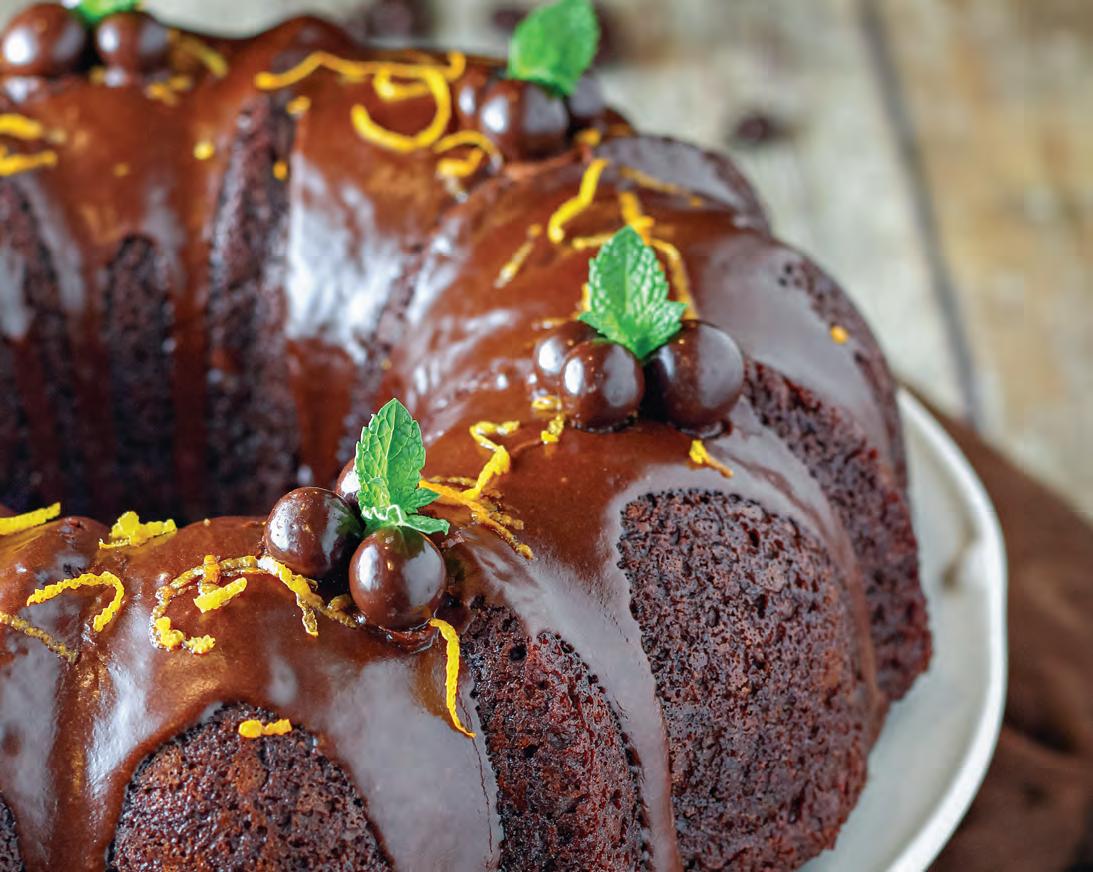
The flavors of orange and chocolate complement each other, finished off perfectly with a chocolate glaze. And no, balsamic vinegar is not a mistake. It enhances the chocolate and orange flavors; no one will suspect the secret ingredient.
With an electric mixer, combine flour, sugar, baking soda, salt, cinnamon and cocoa. Stir in orange juice, mayonnaise, vinegar and vanilla. Mix until just combined. Fold in the orange zest.
Pour the batter into a greased bundt pan and bake at 350° for 45-55 minutes, or until a toothpick comes out clean. Cool in the pan for 10 minutes, then turn out onto a cooling rack to cool completely.
Meanwhile, make the glaze by stirring powdered sugar and cocoa together in a medium bowl. Whisk in orange juice, 1 tablespoon at a time, until glaze reaches a good consistency for drizzling. Spoon the glaze over the cooled cake.
For the cake
3 cups flour
1 ½ cups sugar
2 tsp baking soda
1 tsp salt
1 tsp ground cinnamon
1/2 cup cocoa powder
2 cups orange juice
3/4 cup mayonnaise
2 Tbsp balsamic vinegar
2 tsp vanilla extract
2 Tbsp finely grated orange zest
For the glaze
1 cup powdered sugar
2 Tbsp cocoa powder
2 Tbsp orange juice
Ser ves 12-16
This no-bake layered dessert made with orange Jell-O, cream cheese and whipped cream has all the flavors of the classic orange ice cream treat!
Mix graham cracker crumbs and butter and press onto bottom of an 8-inch square pan. Refrigerate until ready to use.
In a small bowl, microwave juice for about 1 minute on high. Add juice to gelatin mix in small bowl; stir until completely dissolved, about 2 minutes.
Gradually add mixture to half the cream cheese in a medium bowl, beating with a mixer after each addition until blended. Whisk in 1 cup Cool Whip. Spread over crust and freeze while preparing next layer.
Beat remaining cream cheese and milk in a separate medium bowl until blended.
Add dry pudding mix and beat for 2 minutes.
Stir in remaining Cool Whip and orange zest. Spread over gelatin layer. Refrigerate at least 3 hours before serving.
1 cup graham cracker crumbs
3 Tbsp butter, melted 1/2 cup orange juice
1 3 oz-package Jell-O orange flavor gelatin
1 8 oz-package cream cheese, softened
1 8 oz-tub thawed Cool Whip 1/2 cup cold milk
1 3.4 oz-package Jell-O instant vanilla pudding
2 tsp orange zest
Ser ves 8
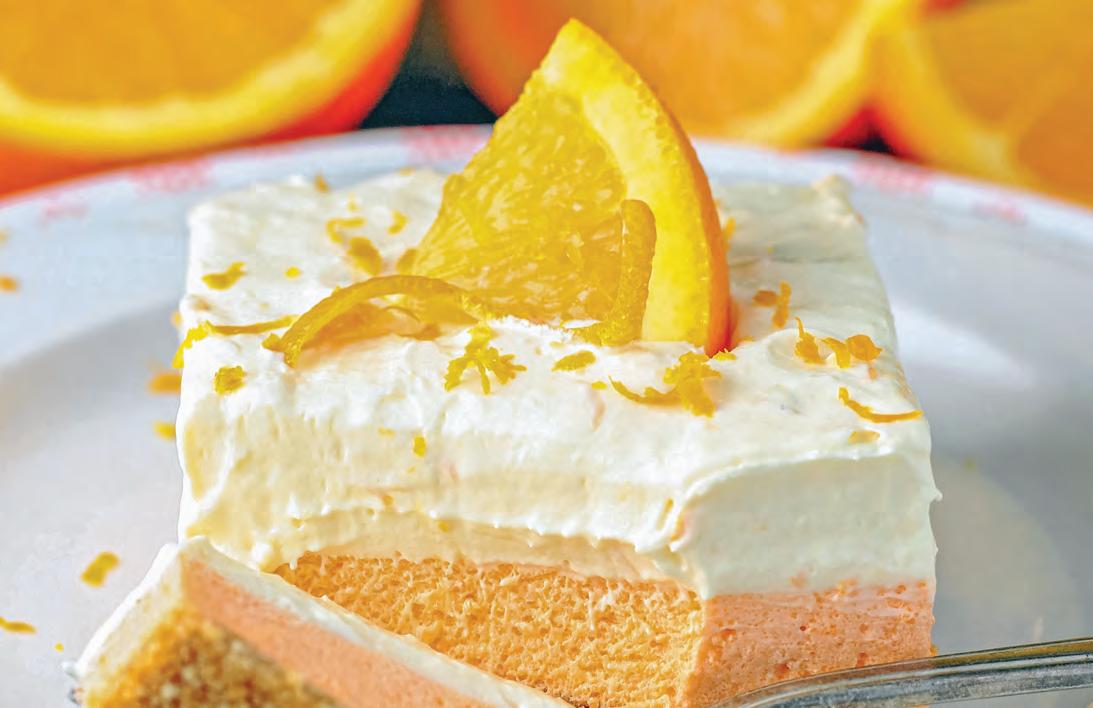
The editors are interested in featuring your favorite family recipes. Send your recipes (and memories inspired by your recipes) to editor@coloradolifemag. com or mail to Colorado Life, PO Box 270130, Fort Collins, CO 80525.

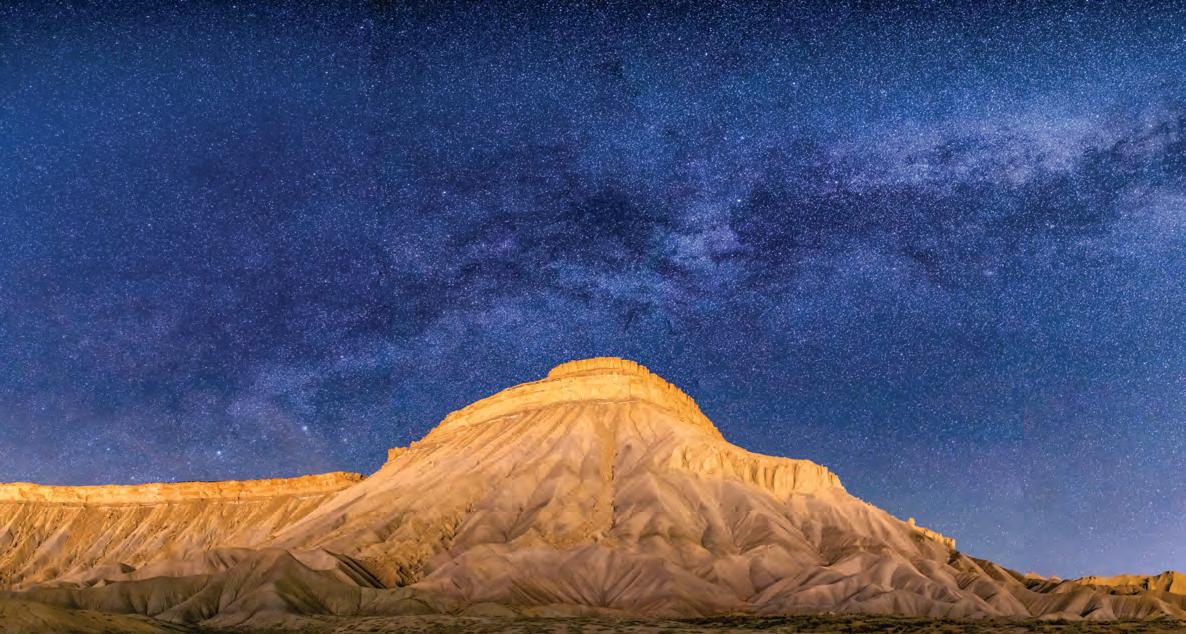
As the sun wanes behind the mountains, stars grow bright under the light of a gentle moon. From Dark Sky Parks to backpacking trails to overnight road trips and city skylines, our poets are inspired by Colorado’s dark skies.
Vaughn Neeld, Cañon City
Rest beneath a curtain of midnight stars. Let darkness embrace you until bright fields of stars burst into flamboyant light that streaks like quicksilver across the blackness of the marvel of this ebony night.
Cher L. Tom, Palisade
Snow swirls soften the cougar tracks parading Past flimsy canvas tent walls standing near Leaf-stripped aspen trees resting in the winter season.
Night perches over Crag Crest leaving its velvet darkness
Like a painter’s brush gone wild.
An unzipped flap of cloth fights against the blowing snow Tinged with blizzard possibilities.
Minutes and hours trudge through the night
Until rainbow streaks of light camp over the summit. My breath warms, blowing against the fresh-brewed tea Dancing lightly until darkness cycles back waiting for the sun
Marina J. Ashworth, Denver
We see woods, deserts and plains
Most oft in the sheen of the day
When soleil shifts to the other side
Dark Skies and her stars come to play
The air calms and enjoys its repose
Hears an opus that plays only at night
The Fauna chat and rumpus of dark
Pet our cheeks and ears with delight
At night we nestle inside of our homes
Yet, still drawn to look out of the window
Primal noc chants whisper soft to our souls
Those Auld Songs deep down that we know
Stars illume, and start winking their eyes
To us, held entranced by their shine
Sentinels true, aye, in keeping the watch
Of Dark Skies and their place in true rhyme
Sandy Morgan, Colorado Springs
All day the sky gathered scraps of cloud in a drawstring bag.
Tonight the sky may spill with snow: it is time – past time; the trees so bare,
creeks and lakes stiff but not frozen. I watched a wren who needs do leave
but won’t until it snows. Juncos have returned, their gray obscured by gray
woods that wear no winter gown of lavender shadow and pearls of light.
The sky darkens and lowers onto tips of forest – pine, spruce and fir.
Winter rides heavy on the wings of night –even if I wish it were not so: it comes.

Robert Basinger, Rifle
Tent, fire, moon
Shifting sands and a plastic spoon
Campfire coffee, wild crazy hair
I smell like smoke, but I don’t care.
Big fun, no worries
My pace has slowed, no need to hurry
Time has slowed down to a crawl
Shadows lengthen, coyote calls.
I let the fire read my thoughts
The air is cool, the embers hot
I’ve worked real hard and come so far
Life is but a shooting star.
A scenic view, a dusty trail
I’ve left the land of junk mail
And it doesn’t get much better than this
So, I don’t need to make a wish.
Charles Ray, Evergreen
no stars tonight only the moon can peek through these dark stormy clouds
Send Your Poems on the theme “Snowmelt” for the March/April 2025 issue, deadline Jan. 1 and “Ascend” for the May/June 2025 issue, deadline Feb. 1. Email your poems to poetry@coloradolifemag.com or mail to the address at the front of this magazine.

story by CORINNE J. BROWN
photographs by BILL PATTERSON
EACH YEAR, the Colorado Cowboy Gathering in Golden brings together Western music fans, storytellers and poets, creating an experience that feels like a journey into the past. Now in its 34th year, the Gathering showcases the Rocky Mountain State’s Western heritage through poetry and song, preserving traditions with authenticity and heart.
“Poetry,” says Susie Knight, a renowned Colorado cowgirl poet, “is the best way to tell a story. By putting it to rhyme and meter, we hear that story differently.”
A seasoned performer at the Gathering, Knight captivates her audience with songs about love, loss and horses, reminding listeners that the Western spirit

Cowboy poetry, a long-standing oral tradition, began as a way to capture the stories of rural life. For many attendees, the Gathering feels like a family reunion –a place where a community of poets, singers and storytellers come together, bound by their love for Western culture.
One poet who embodies this spirit is Terry Nash, a full-time cattle rancher from Loma, west of Grand Junction. Known for his wit and keen observations on ranch life, Nash is what many would call “the real deal.” With his white Van Dyke beard, steely blue eyes, and calm demeanor, Nash’s presence evokes the rugged authenticity of the Western lifestyle. His stories, shared in verse, bring listeners into a world many yearn to connect with.
“I write about my life, my work, and my heritage,” says Nash. “In fact, it’s been said you can say more in a poem than you can in a book.”
COWBOY GATHERINGS aren’t limited to Colorado; they span the American West, from Texas to Oregon, and even reach as far as Canada and Australia. Performers, both new and seasoned, are invited to participate, bringing the best
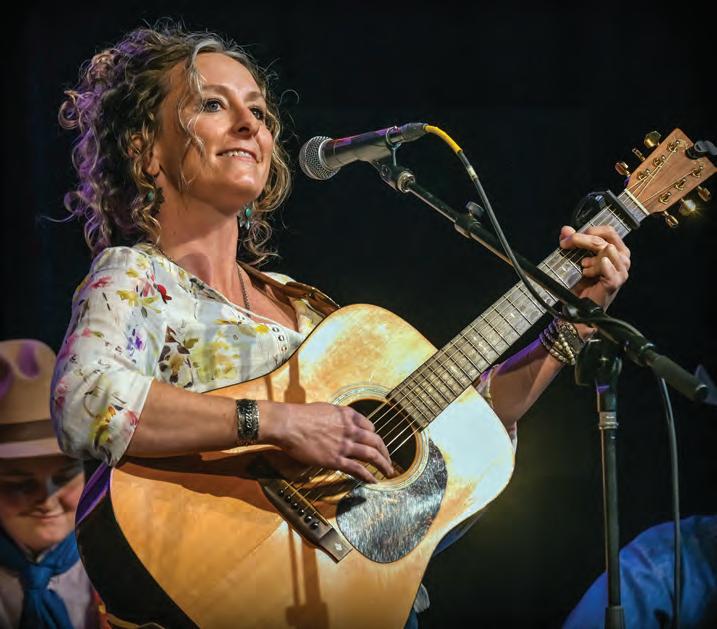


of Western storytelling and song from around the world.
Each January, the Colorado Cowboy Gathering welcomes as many as 16 award-winning performers, including a Saturday night headliner. Originally held at the Arvada Center, the event has recently moved to the Buffalo Rose Event Center, a rustic venue in downtown Golden that adds intimacy to the performances with its raised stage and dance floor.
“Each January, we kick off the new year with sights, sounds, and imagery that take you beyond the confines of life in the 21st century,” said prior event coordinator and president Maryanne Patterson. “Our hope is that as you listen, you feel transported to the past, experiencing the songs and poetry that echo the spirit of the Old West.”
WINTER IS A NATURAL time for cowboy gatherings, as ranch work slows with the season. For many ranchers, this is the perfect opportunity to swap stories, reunite with friends and celebrate their shared heritage.
Even in challenging times, the Colorado Gathering goes on. Several years ago, when Texas musician Jean Prescott had to leave unexpectedly after contracting COVID, the Gathering quickly adjusted. Local musicians Kit Simon and Ernie Martinez stepped in to ensure the show
continued. The sense of camaraderie and mutual support is a testament to what many call “the cowboy way.”
Behind the scenes, a dedicated team of volunteers makes the Gathering possible. From handling sound and lighting to managing ticket sales and publicity, these volunteers ensure the event runs smoothly year after year, helping bring new voices to honor the Spirit of the West.
The 2025 event promises a lineup of award-winning performers, including Kansas trio 3 Trails West; Floyd and Valerie Beard from Kim; Patty Clayton from Edgewater; Doug Figgs, a farrier from New Mexico; and Terry Nash. Each act brings their unique voice, paying homage to the pioneers who settled the frontier.
A poem that resonates deeply with attendees is Nash’s “The Cow Man’s Lot,” capturing the dedication and resilience of ranchers who brave the harshest conditions for the sake of their animals. “Most cow men, at the end of the day, will likely reflect on this thought; he asked for this job, and it weren’t for the pay; it’s the love of the cow man’s lot,” Nash said.
School outreach programs include performances, history and demonstrations such as rope tricks.


FRIDAY, Jan. 17 at 1 p.m.
Dennis and Beverly Gray Russell, known as the Russellers, share original music and poetry inspired by their southern Colorado ranch along the Huerfano River.
FRIDAY, Jan. 17 at 7:30 p.m.
Opening act Peggy Malone, a Fruita native and Emmy winner, brings nearly 60 years of Western performance experience, including her famous “Singin’ a Cowboy Song.”
SATURDAY, Jan. 18 from 10 a.m. to 5:45 p.m.
Rancher and poet Floyd Beard from Kim presents his award-winning Western poetry. Beard has been named Male Poet of the Year by the International Western Music Association four times.
SATURDAY, Jan. 18 at 7:30 p.m.
Award-winning artist Patty Clayton from Edgewater, known for her “voice as pure as the prairie wind,” takes the stage with songs celebrating the Western spirit.
Visit coloradocowboygathering.org to purchase tickets and see full schedule of performers.
by ARIELLA NARDIZZI
DEC. 12-14 • BRECKENRIDGE
A Viking-helmet-clad throng gathers on Breckenridge’s Main St., their breath fogging in the chilled air. The powder hounds chant fervently for Ullr, the Norse god of snow, to dump fat, white flakes upon the ski slopes this season. Discarded Christmas trees fuel a bonfire. Roaring flames leap 10 feet high. The spirit of winter
comes alive during the 61st Ullr Fest, a whimsical celebration from Dec. 12-14.
The eccentric Norwegian-inspired gathering transforms downtown Breckenridge into a vibrant spectacle of winter merrymaking. In Norse mythology, Vikings revered Ullr, Patron Saint of Skiers, as a master of hunt and protector of win-
ter landscapes. Local ski legends Sigurd Rockne and Trygve Berge launched the first Ullr Dag Festival in the 1960s. The humble homage grew into Ullr Fest, a lively celebration that honors the snow god’s generous gifts to Breckenridge each winter.
The weekend kicks off on Thursday with a crafty Viking helmet decorating
Skiers, snowboarders and locals line up on Breckenridge’s Main Street to usher in the snow season, paying homage to the Norse god of snow.

party at 11:30 a.m. Headgear festooned with faux fur, sparkles and beads will later twinkle in the moonlight at the inaugural parade down Main St.
At 3 p.m., the Ullr King and Queen crowning unfolds at Blue River Plaza to honor two local legends who embody the spirit of Breckenridge. The title not only recognizes their snow-fueled stoke but also their contributions to the community.
The heart of the festivities culminates at the exhilarating Ullr Parade. A kaleidoscope of floats snake through Main St. at 4 p.m. Celebrants don horned helmets as cheers reverberate throughout town. Partygoers dance, clap and cheer to their favorite Norse god.
As twilight descends, the Ullr bonfire ignites the evening sky at 5 p.m. Under the moonlight, townsfolk sway together, the flickering flames casting playful shadows on Breckenridge’s charming architecture. As burning wood crackles throughout the night, they pay homage to Ullr for an abundance of snow.
This wild celebration is a jubilant nod to Breckenridge’s beloved ski heritage. After all, who wouldn’t want to party for a powder-filled ski season ahead? gobreck.com.

CABIN JUICE EATERY & BAR
Appreciate Breckenridge’s après culture at this farm-to-table lodge. Organic proteins and produce are sourced from Front Range and Western Slope farms featuring an aromatic curried salmon with saffron rice or rich tomato campanelle with white wine. 605 S. Park Ave. (970) 423-2299.

Just a short jaunt from Main Street, this elegant mountain retreat is the best spot to unwind after Ullr Fest. Lounge by the crackling hearth and relax in the hygge-inspired rooms. 275 Ski Hill Road. (970) 343-4702.
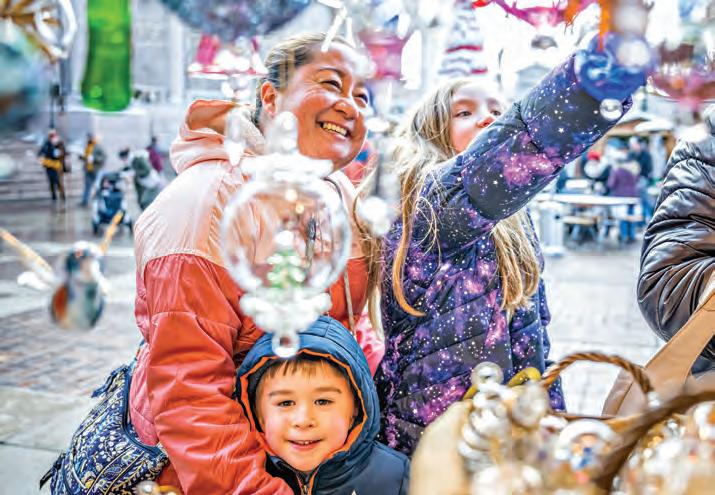
THROUGH DEC. 23 • DENVER
It’s the 16th century in Nuremberg, Germany. The world’s oldest and most famous Christmas Market’s intricate wooden stalls bustle with seasonal delicacies and handmade crafts. An intoxicating aroma of roasted nuts and spiced mulled wine fill the air. Folklore says Christkind, a fairylike figure with golden locks and angelic wings, bears gifts to children. Over the years, Nuremberg’s Christkindl market has inspired countless spurs across the globe. Each European market honors the deep-rooted traditions that make it a hallmark of the season.
In Denver, the Christkindlmarket transforms Civic Center Park into a German-style winter wonderland. It has evolved from humble beginnings in 1998 to a sprawling cultural celebration with over 40 vendors. The German American Chamber of Commerce-Colorado Chapter creates a cultural exchange while providing a platform for local German artisans and businesses.
Twinkling lights adorn each wooden hut. The sweet smell of Glühwein, a warm concoction of spices and wine imported directly from Germany for the event, wafts through the streets. Central European lore Krampus, half-goat, half-demon monster, graces the event. He punishes misbehaving children before St. Nicholas arrives to bestow gifts.
Friends huddle around crackling fire pits, roasting marshmallows and warming knotted Bavarian soft pretzels over the flames. Visitors meander among stalls showcasing handcrafted treasures that echo the rich traditions of Europe. VISIT DENVER’s iconic Mile High Tree explodes in iridescent color, illuminating the festivities in a shimmering light. Prost to cherished holiday memories which will linger long after the last mug of Glühwein is raised.

The German cultural tour in Denver continues at Rhein Haus for beers, brats and a round of bocce. Try traditional pork schnitzel, hearty beef goulash stew or an exceptionally smooth German Pilsener. 1415 Market St. (303) 731-5374.

Look for the elegant, star-topped Victorian mansion for a luxurious stay in Denver’s Potter Highlands district.
The quaint bed and breakfast intimately houses five rooms, all with private Jacuzzi tubs. 2555 W. 37th Ave. (303) 477-8205.

In Nature’s Studio Through Feb. 8 • Loveland
Explore the brushstrokes of American arts’ history from the early 19th century through early 21th century. The Loveland Museum exhibit features over 65 varying landscape paintings, from Impressionism and Tonalism to Modernist movements. 503 N. Lincoln Ave. (970) 962-2410.
Christmas at the Ranch
Dec. 13-28 • Monument
Mini Highland cows, alpacas, goats, sheep and ponies await. Take a tractor ride through 200,000 lights while munching on barbecue sandwiches and funnel cake. Stroll through Candy Cane Lane with your hot cider or hot chocolate. 2205 E. Highway 105. (719) 799-6708.
The Commedia Christmas Carol
Dec. 13-15, 20-22 • Trinidad
It’s classic Dicken’s “A Christmas Carol,” but only eight players perform a dynamic adaptation in Italian commedia dell’arte style to bring the Victorian world to life. Friday and Saturday shows start at 7 p.m. Sunday’s matinee is at 2 p.m. Main Street LIVE, 131 W. Main St. (719) 846-4765.
Christmas at the Hamill House
Dec. 14, 21 • Georgetown
Come one, come all to celebrate an authentic late-1800s holiday evening at the Hamill House, a historic silver baron’s home. Carry on the Yule Log tradition and enjoy a majestic appearance from Saint Nicholas himself. Guests are encouraged to get into character and wear attire from the period. 305 Argentine St. (303) 569-2840.
Artisan’s Winter Market
Dec. 14 • Fort Garland
The Fort Garland Museum welcomes merrymen to enjoy holiday gifts from local artisans, musical performances and prizes. Enter the 3rd annual Biscochito Bake-Off featuring traditional New Mexican cookies. 29477 Highway 159. (719) 379-3512.
Winter Wine Wonderland
Dec. 14 • Palisade
Celebrate in wine country with tastings from six local wineries. Sip and savor your wine while perusing the stalls of 20 vendors’ handmade creations and dine at the Pali Thai food truck. The Ordinary Fellow, 202 Peach Ave. (970) 464-2185.
Annual Winter Celebration
Dec. 15 • Fleming
Fleming’s fire department throws their annual holiday extravaganza with delectable chili and cinnamon rolls, hot cocoa, crafts, local vendors and a visit from Mr. and Mrs. Clause. 400 Pawnee St.
Great Santa Soak at Mount Princeton Hot Springs
Dec. 15 • Nathrop
Even Mr. and Mrs. Claus deserves a day off. Soak in the holidays while relaxing in natural hot springs, hosted by Mount Princeton Hot Springs, from 9 a.m. to noon. The first hundred guests will receive a free Santa hat. Overnight guests enjoy the soak for free. Historic Bath House, 15870 County Road 162. (719) 395-2447.
New Year’s Eve Torchlight
Parade and Fireworks
Dec. 31 • Telluride
Ski and snowboard instructors hold flaming torches high as they zigzag down the mountain at 6:30 p.m. Fireworks illuminate the sky above them, ushering in the new year with spectacular lights. Telluride and Mountain Village. (800) 778-8581.
National Western Stock Show
Jan. 11-26 • Denver
The Wild West comes to Denver with riveting, non-stop family fun across the city. Cheer in the rodeo arena at the celebrated Mexican Rodeo, witness top-tier equines at the dramatic Evening of Dancing Horses or take a step back in time to the era of Buffalo Bill at the Wild West Show. Multiple venues around Denver. (303) 297-1166.
Skis and Saddles SkiJor
Jan. 18-19 • Pagosa Springs
Celebrate southern Colorado’s rich cowboy culture on skis. At the Archuleta County Fairgrounds, skiers of all ages slalom across the snow, hitting acrobatic jumps and riding through hoops, as a horse pulls them through a challenging obstacle course. 344 US 84. (970) 759-0815.
International Snow Sculpture Championships
Jan. 20-29 • Breckenridge
The 33rd annual competition returns as historic downtown Breckenridge transforms into an open-air art gallery. Snow artists from around the world spend 100 grueling hours turning towering, 25-ton snow blocks into elaborate, hand-carved, museum-worthy sculptures. Event is free to the public, but timed reservations are required on select dates. Riverwalk Center, 150 W. Adams Ave.
X Games Aspen
Jan. 23-25 • Aspen
The world’s best snow sports athletes descend on the slopes of Aspen Snowmass’ Buttermilk Mountain for a jaw-dropping, action-packed competition. Skiers and snowboards backflip through air, conquer the halfpipe and glissade at astonishing speeds. Buttermilk Ski Resort, 38700 CO-82. (800) 525-6200.

Ouray Ice Festival
Jan. 23-26 • Ouray
Top-tier international climbers compete at the 30th annual ice fest, hanging on frozen waterfalls with the sharp picks of their ice tools and crampons. The weekend’s festivities include free gear demos, a dance party and vendors. All fundraising from the event directly contributes to the ice park’s upkeep. Ouray Ice Park, 280 CO Road 361. (970) 325-4288.
Renée Fleming
Jan. 31 • Boulder
Renée Fleming’s rich soprano performance will fill every inch of Boulder’s Macky Auditorium. Fleming is an impressive five-time Grammy Award winner, Kennedy Center honoree and one of the best classical artists to perform at opera houses around the globe. Show begins at 7:30 p.m. Macky Auditorium Concert Hall, 1595 Pleasant St. (303) 492-8008.




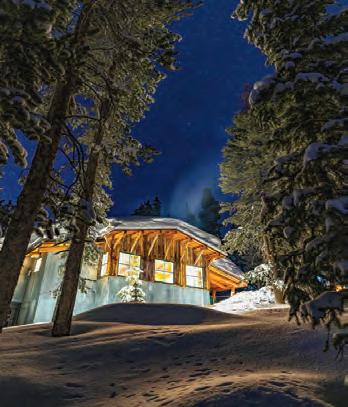



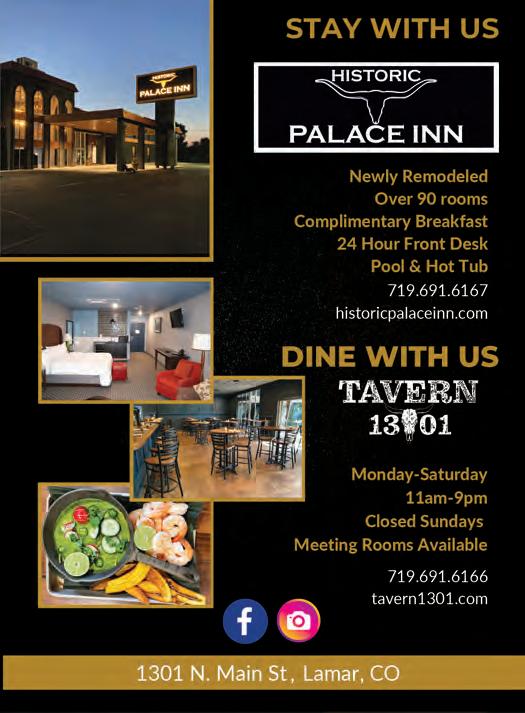


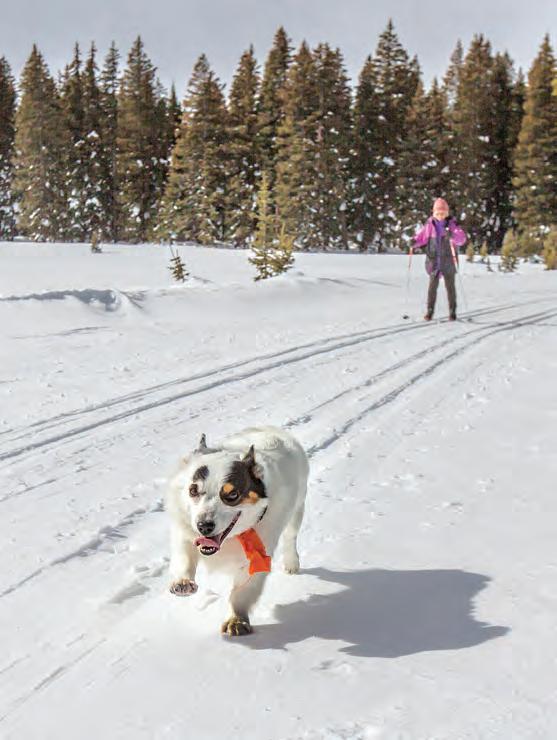



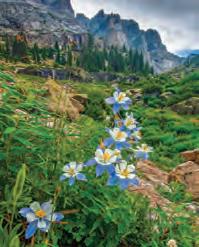


story and photographs by
DAN LEETH
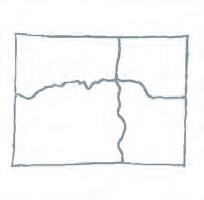

LOCATION
12 miles southwest of Lake George
TENT RV/SITES
Both
ACTIVITIES
Fishing, sailing, canoeing, kayaking, windsurfing, biking, birding, cross-country skiing, backcountry camping, hiking, climbing, hunting, ice fishing, ice skating, picnicking, playgrounds
Eleven Mile Canyon offers camping at a sprawling reservoir or near a tumbling trout stream
AFEW MONTHS AGO, FRIENDS invited my wife and me to join them on a camping trip to Eleven Mile State Park, a place we hadn’t visited for years. Always eager to have someone other than her husband to gab with around the campfire, my spouse jumped at the chance.
Our friends are avid anglers, and Eleven Mile, which encompasses a six-mile-long reservoir on the South Platte River, has become one of their favorite camping spots. Here, they can hook rainbow, cutthroat, cutbow and brown trout as well as northern pike, kokanee salmon and carp.
The park offers 326 campsites scattered around the reservoir with flush toilets, showers and laundry facilities available
during summer months. While the bulk of the sites are basic, the park features 52 RV campsites with electric hookups. Surrounded by predominantly treeless grasslands, the state park offers an expansive, wide-open feel, ideal for ogling leprechaun-worthy rainbows, Bronco-orange sunsets and black velvet nights sequined with stars.
While our friends spent their day fishing, we went hiking. The park offers several looping trails that when combined can provide a pleasant five-mile stroll through hills and wetlands on the eastern side of the reservoir. We encountered fellow hikers on the trail toting bird-spotting binoculars. Birders here, we learned, have spotted over 200 different species ranging from broadtailed hummingbirds to bald eagles.
Those searching for featherless wildlife might spot cottontails, jackrabbits, porcupines, badgers, muskrats, weasels, chipmunks and ground squirrels along with coyotes, bobcats, mule deer, pronghorn and elk. Trailhead signs warned us
of bear activity, but we fortunately failed to encounter any burly bruins.
That evening, our friends asked if we’d ever explored Eleven Mile Canyon Recreation Area in the Pike National Forest below the dam. We hated to admit that we had not. After advising us that the Forest Service charges an access fee, they described what sounded like a John Denver song come to life and suggested that we check it out.
The next day, we drove to Lake George and followed a pair of county roads to the entrance station where we paid a $10 fee. We continued up a graded, streamside road that was once the route of the Colorado Midland Railroad. Beside us, the South Platte River thundered by, cascading over boulders in a churning blend of clear, blue-hued water capped in frothy white. Granitic hillsides hemmed the crashing stream, their slopes studded with towering conifers.
We stopped at the Riverside Campground, the first of four located in Eleven Mile Canyon. This one offers 18 reservable campsites, some fitting RVs up to 30 feet in length. It features pit toilets, picnic tables and campfire rings but no drinking water. For old-style fun, the campground offers horseshoe pits, and for us hikers, a forest trail that leads to a ridge-top overlook.
Continuing upstream, the road passes through the first of three railroad tunnels.
Judging the portal’s size, I realize there’s no way tall trailers or large motorhomes could fit through and reach the trio of campgrounds beyond. A travel trailer parked at the Springer Gulch Campground a short distance beyond, however, proves that smaller trailers like ours can squeak through. Like Riverside, Springer Gulch delivers the usual Forest Service campground amenities, but at least here there’s well water available for those willing to use a hand pump.
Two similar campgrounds, Cove and Spillway, lie up the river near the base of Eleven Mile Dam. The towering, 128-foottall, concrete arch dam was completed in 1932 by the Denver Water Board. In the dam’s willow-lined tailwaters, anglers cast flies, hoping to hook the gold medal rainbow, cutthroat and brown trout found here. The fish won’t be for breakfast, however. Up here, it’s strictly catch-and release using artificial flies and lures only.
Back at our state park campsite that evening, I suggested that next time we go camping, we should book a streamside site down in Eleven Mile Canyon Recreation Area. My wife pondered the proposition with a furrowed brow. Then, with the grace of a weaseling politician, she suggested that while she wouldn’t mind camping beside the whitewater stream, she suspected our campfire-gabbing buddies would vote for bunking here, near the flush toilets found in the state park.


Eleven Mile State Park is located off County Roads 90 and 92, 12 miles southwest of Lake George. Basic sites cost $28 per night; electric sites run $36 per night. A daily vehicle pass ($10) or annual pass is also required. There is a dump station available, but not all camping loops possess water spigots. Boats can be rented from the 11 Mile Marina near the Rocky Ridge Campground with basic camping supplies such as beer and ice available at the 11 Mile General Store right outside the park boundary. Reservations required (800-244-5613, cpwshop.com).
Eleven Mile Canyon Recreation Area offers four campgrounds, with many reservable sites. Fees run $22 per night. There is also a one-time fee of $10 to enter. Campsites have picnic tables, campfire rings and vault toilets. Campers should bring their own water, although hand pump water may be available at Cove, Spillway and Springer Gulch. Larger vehicles will not be able to pass through the tunnels beyond the Riverside Campground. Reservations available (877-444-6777, recreation. gov).
13
14

AFTER THE RUSH of leaf peeping photo seekers leaves the high country and the shimmering foliage falls to the ground, many view the following weeks as a time to put their cameras away and concentrate on upcoming holidays. We should rethink taking a seasonal break quite so soon. Unique images that can’t be captured at any other time of the year are possible on the edge of winter.
Several of Colorado’s alpine lakes –which are surrounded by multicolored displays of summer wildflowers or rimmed with aspen stands toned in golden fall foliage – can be snowbound or completely iced over in winter, making them hidden in blindingly white landscapes, inaccessible to hikers or snowshoers. Before this happens, the first weeks when colder weather starts to set in supply photographers with a brief window of opportunity to witness scenes of frost-covered evergreens, mountain peaks sprinkled with snow and ice-lined lakes.
In the months of October and November, even into early December, fewer cars fill parking lots, hiking trails aren’t as crowded and road conditions are typically less hazardous than later in winter. The quiet atmosphere and the slower pace along wet and snow-dusted roadsides highlight the small details throughout the landscapes that we might not otherwise see.
Rocky Mountain National Park is one of my favorite spots to see the early conditions that will characterize the deeper winter ahead. Dream Lake and Sprague Lake are famous for midwinter displays of ice showing bubbles in suspended animation, cracks that reflect the light in luminous shades of aqua and other abstract forms. I’ve written about these before (“Beating

the February blues,” January/February 2017) and they are spectacular. However, lakes at slightly higher elevations, like the park’s Emerald Lake at 10,111 feet, reveal these extremes sooner.
In this column’s photo, interestingly angular ice formations are just starting to form along Emerald Lake’s shore. The fragile patterns frame a reflection of the jagged spires on the slopes of Flattop Mountain. The mountain really is so flat on its summit that it supports one of the park’s most popular hiking trails, though it doesn’t look like it from the perspective along the lake. Getting here is a 3.6-mile round trip from the Bear Lake Trailhead and makes for a pleasurable snowshoe experience.
Other places in the state that might display similar characteristics include the lakes below the Indian Peaks reachable from the Brainard Lake Recreation Area, Saint Mary’s Glacier near Idaho Springs, Lake Irwin near Crested Butte and the popular Ice and Island Lakes near Silverton, among others.
Landscapes aren’t the only subjects available to watch for before winter truly sets in. Wildlife abounds when human audiences wane with the close of fall. Species like elk and Rocky Mountain bighorn sheep begin to dig in for the winter ahead as their ruts end. While animals curtail action-packed performances like sparring, different behaviors emerge. Those that survive the hectic contests for mates display a less aggressive nature and might be more likely to hold still for easier portrait-like compositions.
For those that miss the early winter icy scenes, there will be another chance on the opposite shoulder of winter. The months of March, April and May, even extending as late as early June, also offer options to photograph seasonal changes depending on elevation. Retreating snowpack and the return of warmer weather break the ice and bring liquid water once more. Late spring storms sometimes leave the landscape with spectacularly wet, fluffy snow – an added bonus when combined with budding flowers surrounded by the rocky features of Colorado’s landscapes.
Cold weather season enters and exits bringing subtle changes to the nature around us and opportunities for unique images. Photographers can take advantage of this twice-yearly march, whichever edge of winter they choose to explore. Winter’s icy fingers are waiting.

JOSH SHOT THIS photo at Emerald Lake in Rocky Mountain National Park with a Nikon D300 and Nikon 70-300mm lens at 70mm, exposed at f/16, 1/20, ISO 200.

